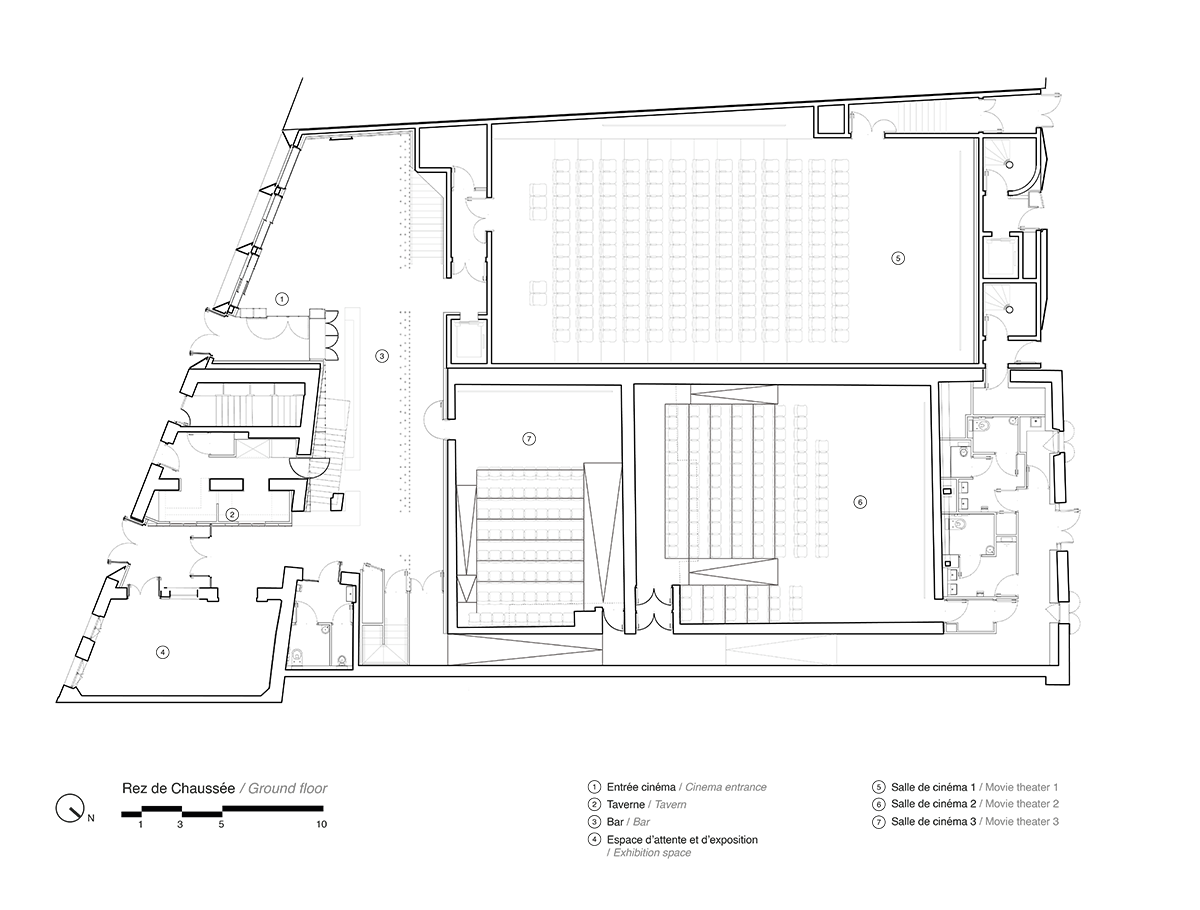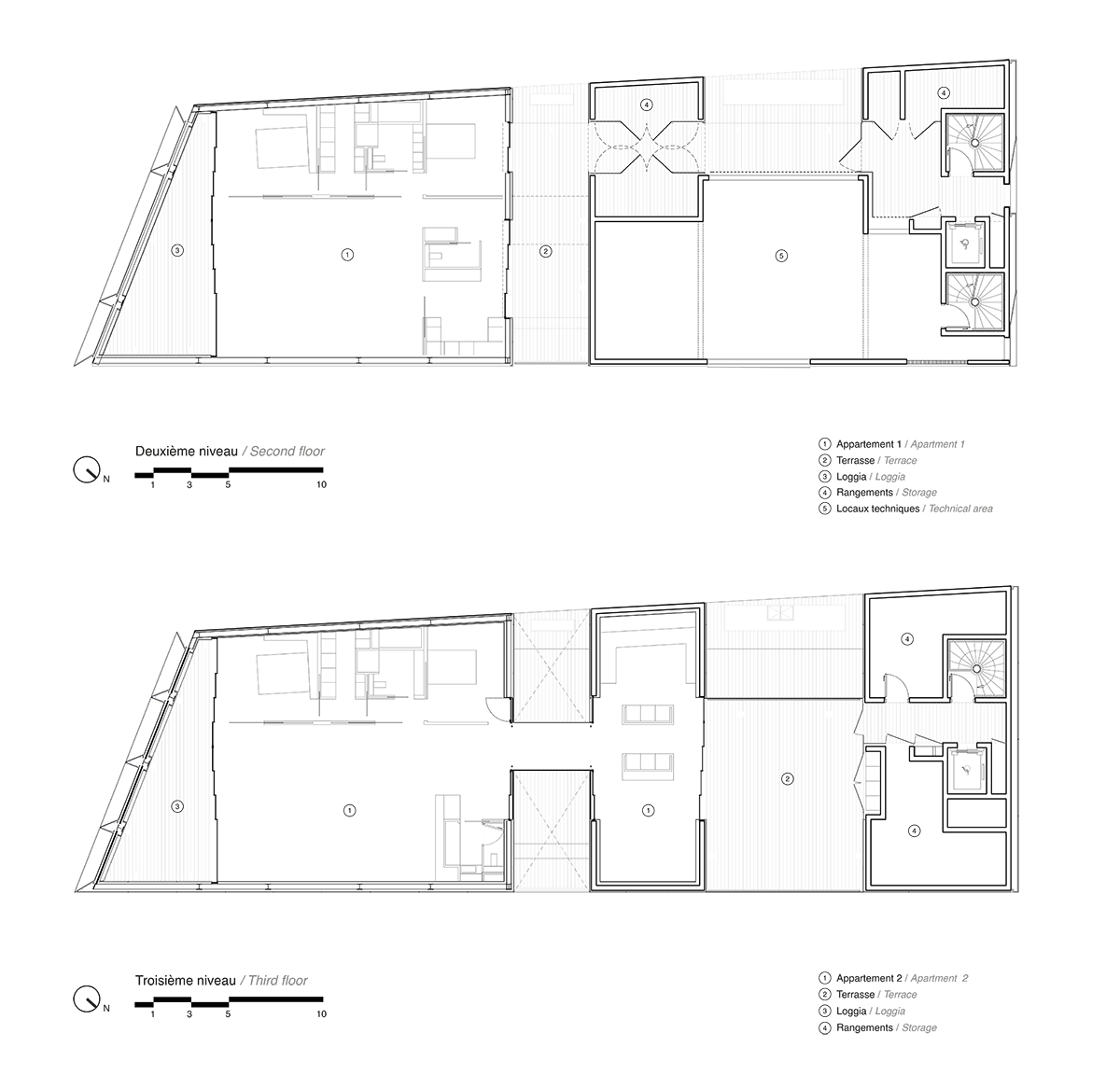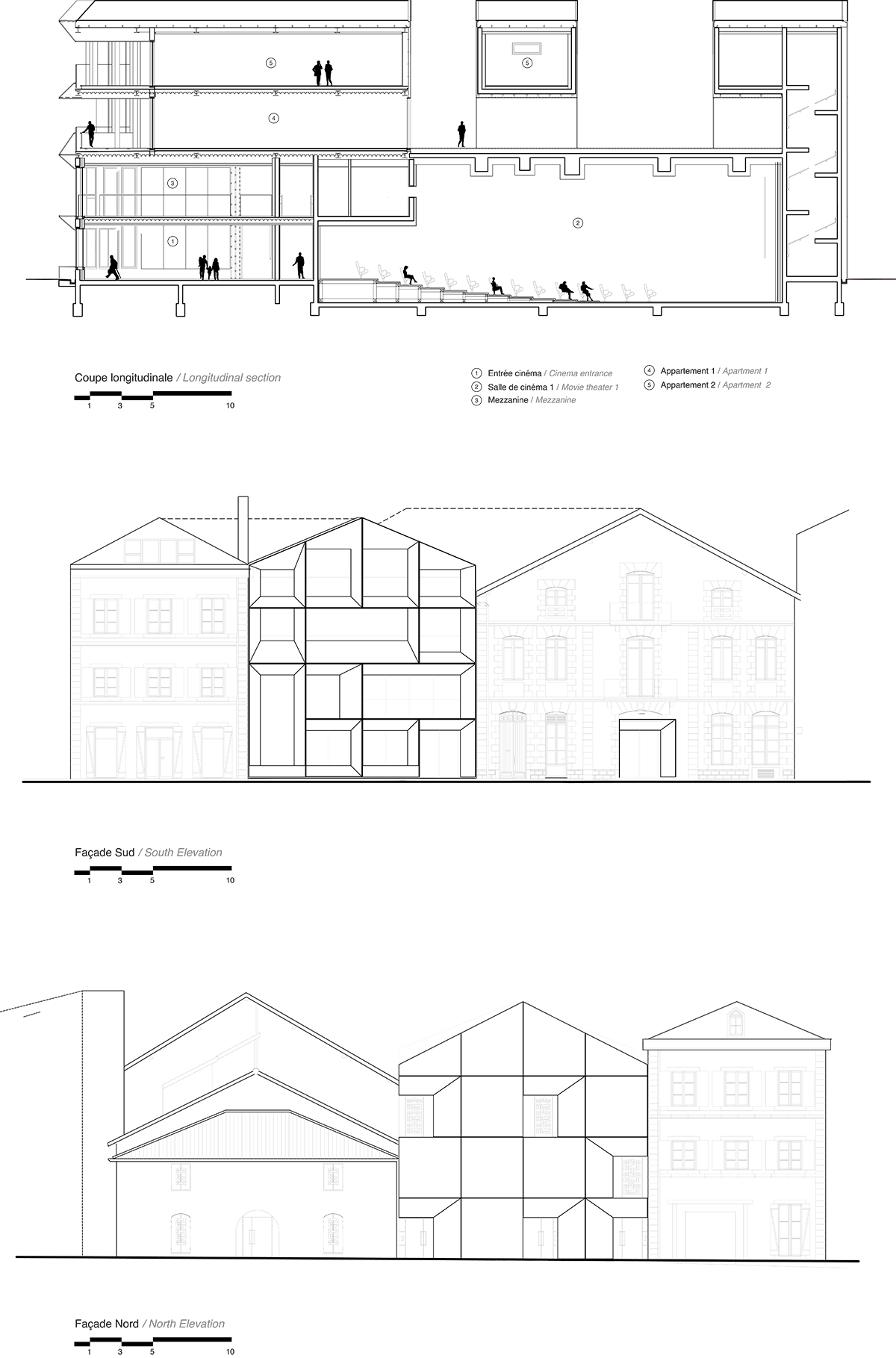bayonne (64)
culture
ART-HOUSE
3 MOVIE THEATRES
CAFÉ-RESTAURANT
LIVE SHOWS & MEETINGS
TWO FLATS
RESTRUCTURATION & EXTENSION
2021 DELIVERY DATE
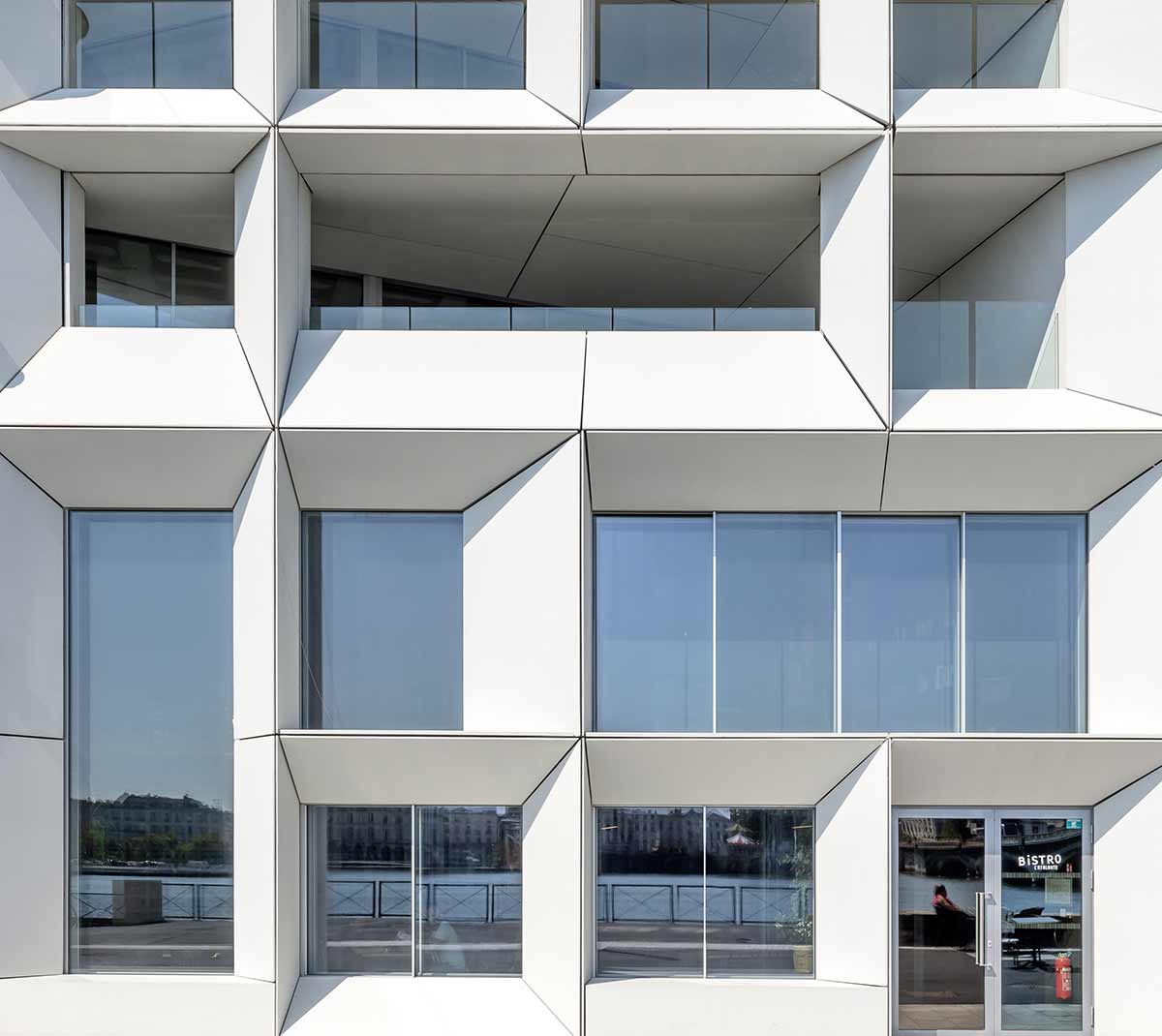
L’ATALANTE, AN ART-HOUSE CINEMA IN BAYONNE
Since its creation in 1990, the Atalante art-house cinema represents an important centre of Bayonne’s culture. It has been managed by the Cinéma & Cultures association. It is located in front of the quai Amiral-Sala on the right bank of the Adour, just below the Saint-Esprit bridge which leads to the city centre. To carry out the project, two cinemas had to be grouped together and refurbished, one of which represented an extension of some 200 seats in the for- mer garage of the adjoining building. The city, the CNC (Centre National de la Cinématographie), and the general and regional councils were the main partners in this pro- ject, which launched the rehabilitation of the Saint-Esprit district. This area around the train station is undergoing a metamorphosis and has a long history dating back to the 12th century: it was the birthplace of Bayonne’s chocolate factories and is home to the citadel built by Vauban at the end of the 17th century, the city’s synagogue (built in 1836), as well as a population of diverse origins, often in transit, as it has been for centuries.
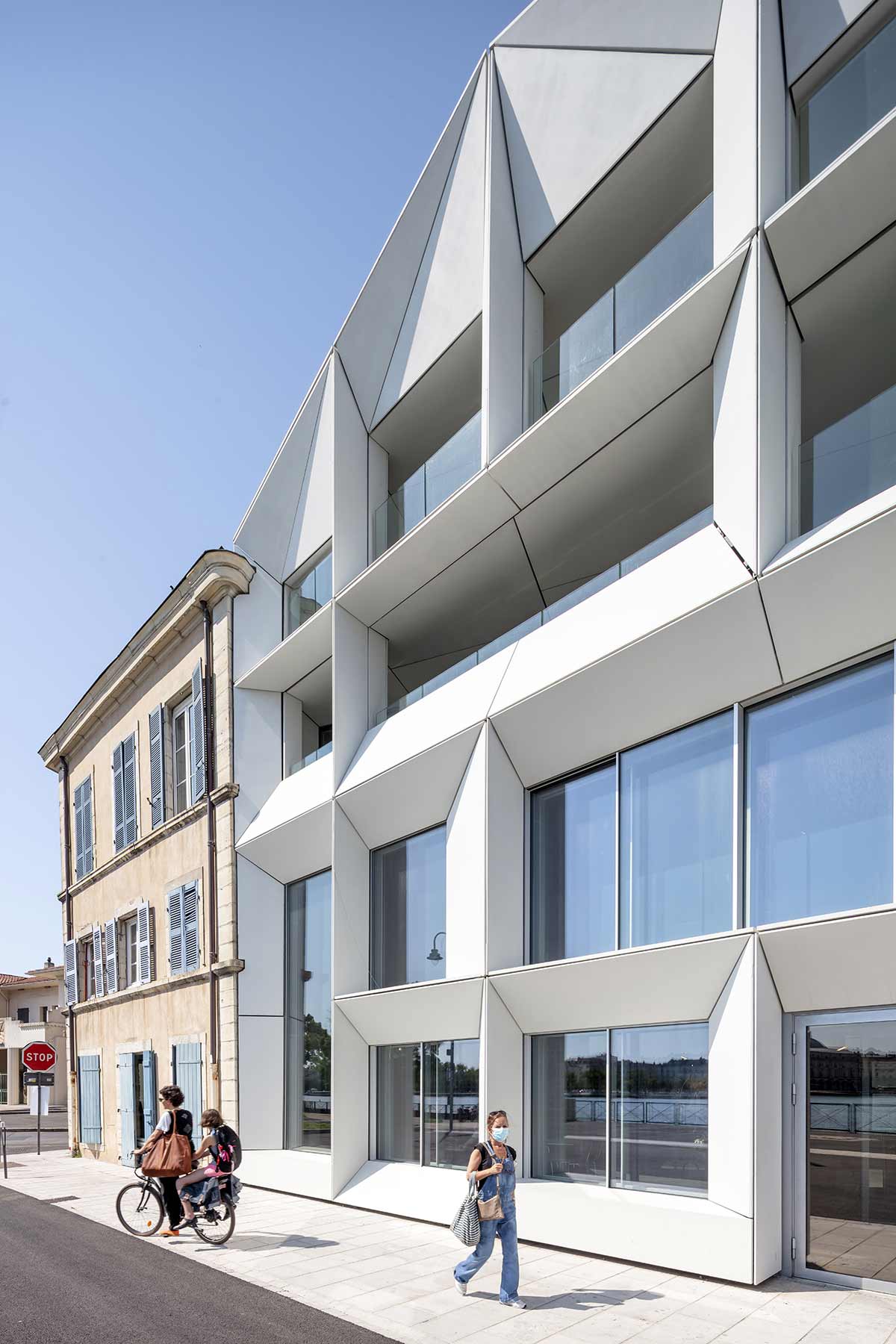
« A BALANCE HAS TO BE ACHIEVED BETWEEN RESPECT FOR THE HERITAGE AND THE SPIRIT OF THE PLACE AND THE CREATIVE DYNAMICS NECESSARY FOR THE DEVELOPMENT OF A CULTURAL SITE. »
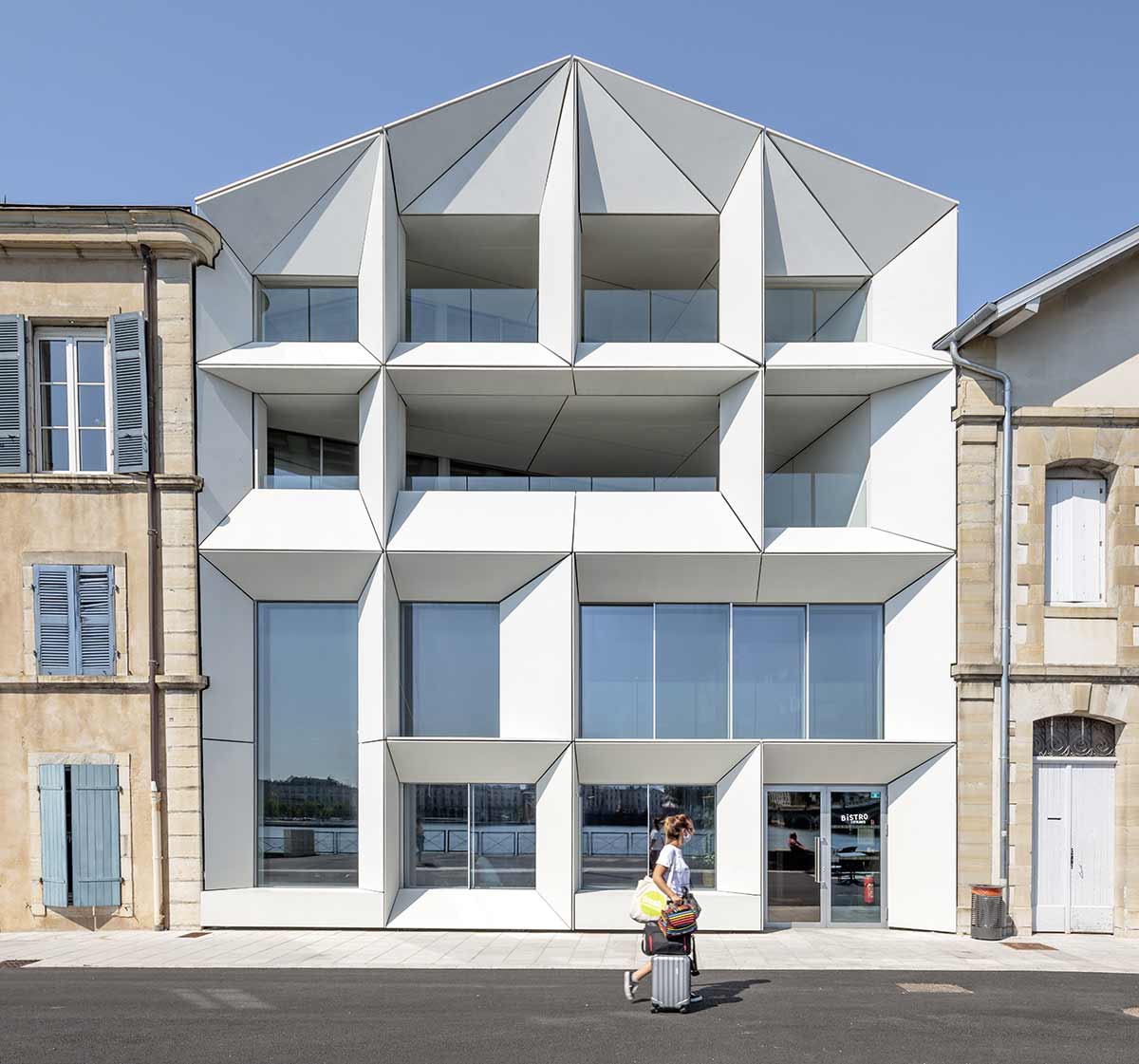
During my first visit, I was quickly aware of the challenge at hand: I had to bring together the historical character of the site with an explicit request to set this cultural space in a strong contemporaneity. I then began to contemplate the possibilities of an architectural modernity respecting the existing building through its capacity to coherently blend into the whole, without seeking to set it apart, to se- parate it, to single it out through contrasting forms, mate- rials or striking colours. The right balance had to be struck between respecting the heritage, the spirit of the place, and the creative dynamic necessary for the development of a cultural site, a theatre where the likes of aesthetic proposals, emotions, considerations and debates would take place to cement our present and to animate our fu- ture.
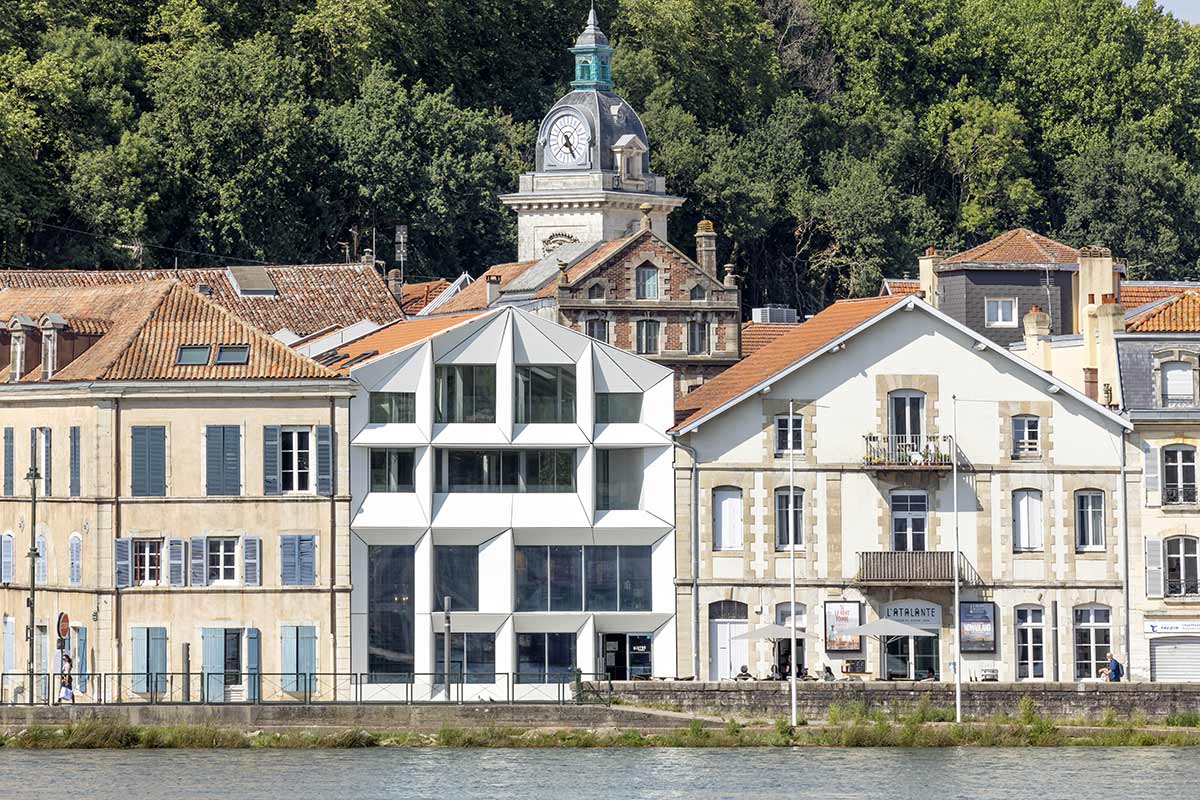
WINDOWS ON THE ADOUR AND OPE- NINGS ON THE CINEMA (AND VICE VER- SA)
A city is made up of windows, of thousands of windows that allow us to glimpse and guess at stories and desti- nies. The facades of Bayonne are rich in openings, which is plain to see all along the Adour. Thus the windows were our focus point and our main concern for the building’s external identity. They enable anyone to see and imagine and let out many signs that lead to interpretations and to possible fictions. Frames exposed to the south-west allow the light on each side to pass through – inside/outside, natural/artificial – in an explicit analogy with the cinema: the seventh art is also a breakthrough on the real and the imaginary, an assembly of framing, of shots, put to- gether to make either moving or senseless stories. The filmmaker records, cuts, combines, constructs, to give meaning and a particular approach to space. I did the same to give this new building a façade. A facade al- together discreet and surprising, integrated and singular, asymmetrical, deconstructed and harmonious, angular and wise, soft and open… Thus, large amplified windows, altogether mismatched and matched in size, materialise this concept, like an architectural vision stemming from the expressionist tradition (and its cinematographic trend!), but whose design and organisation would be subdued by an original polish, an innovative delicacy and clarity, a subtle and gentle lighting. The whole remains in harmony with the exterior facades of all the neighbouring houses and the slow movements of the Adour waters, which also pass by without being able to be stopped… Windows open to the imagination and dreams on film, which will give passers-by a glimpse of scenes, movements, silhouettes, lights, life and collective activity: the cinema becomes like an unexpected and ever-changing film set.
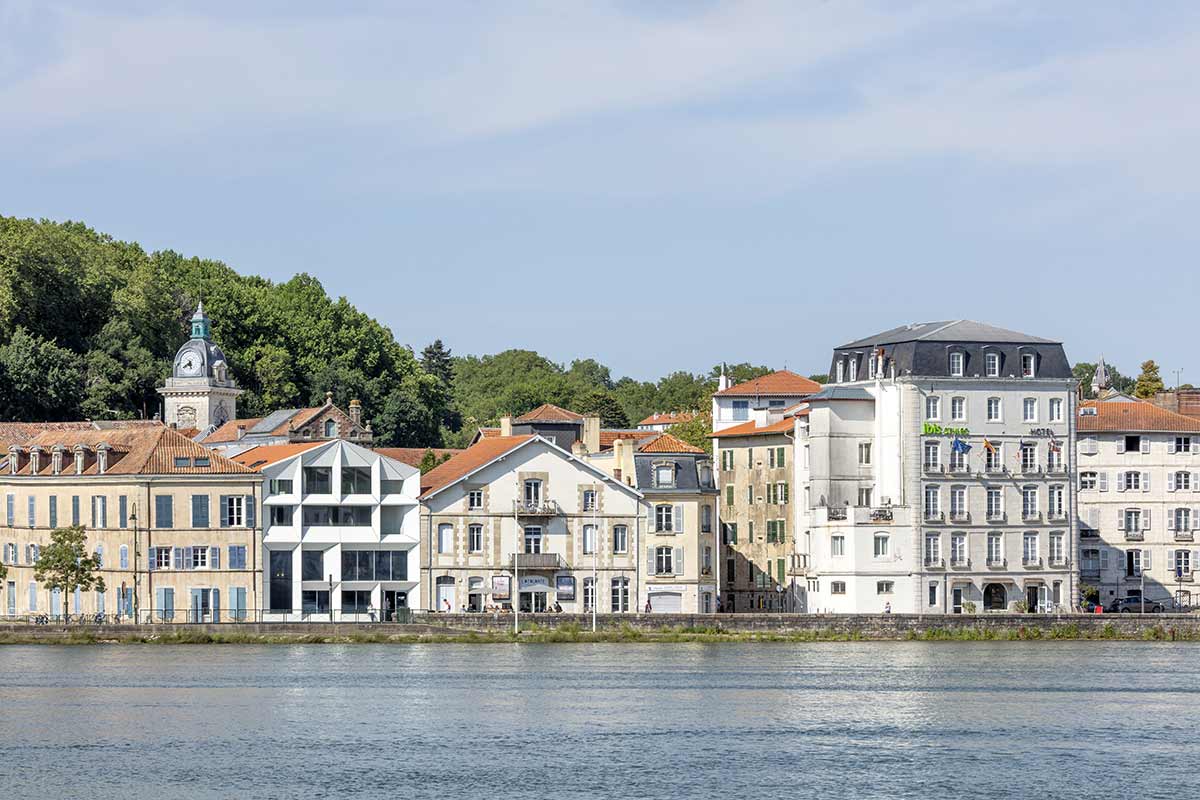
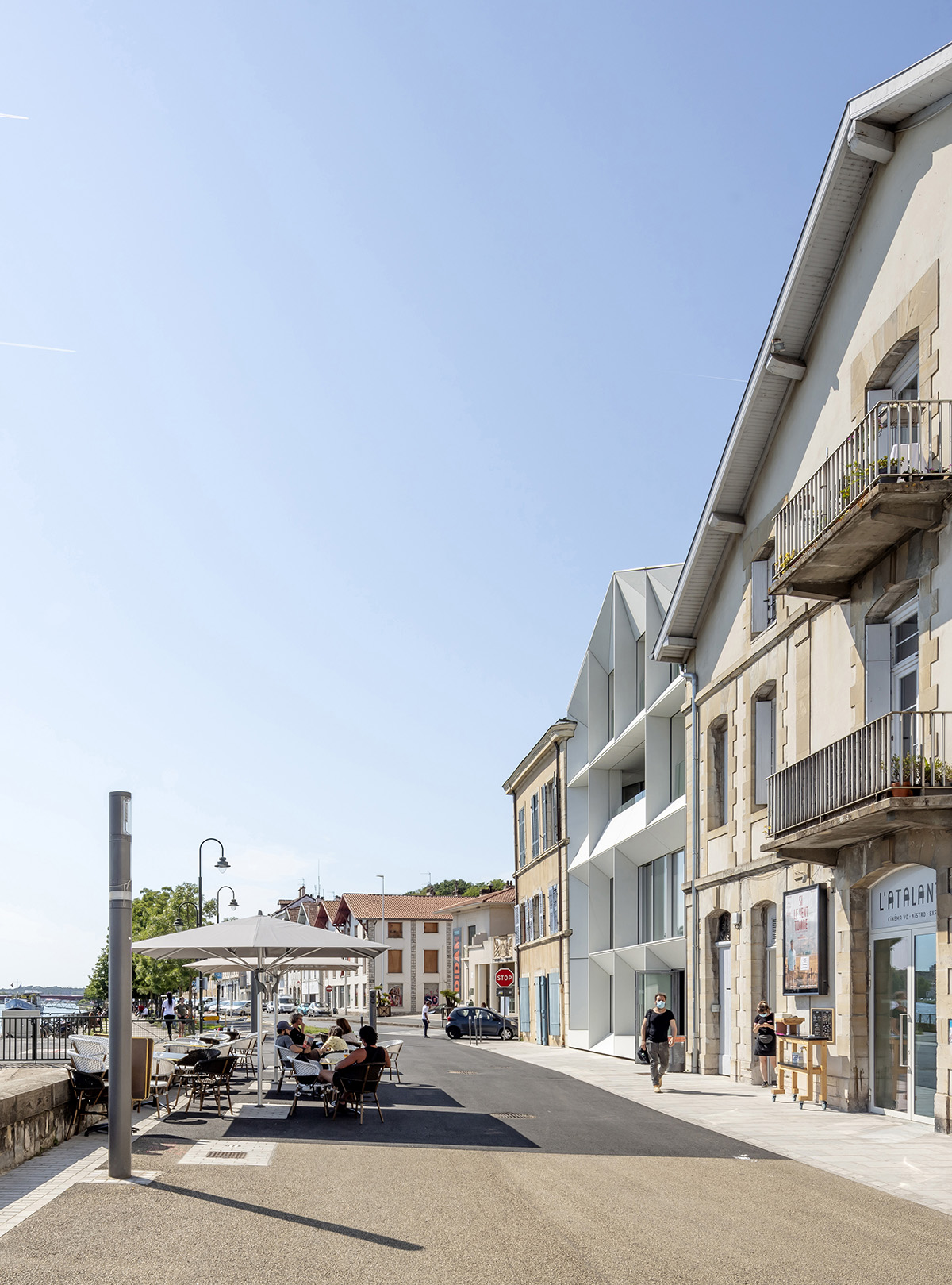
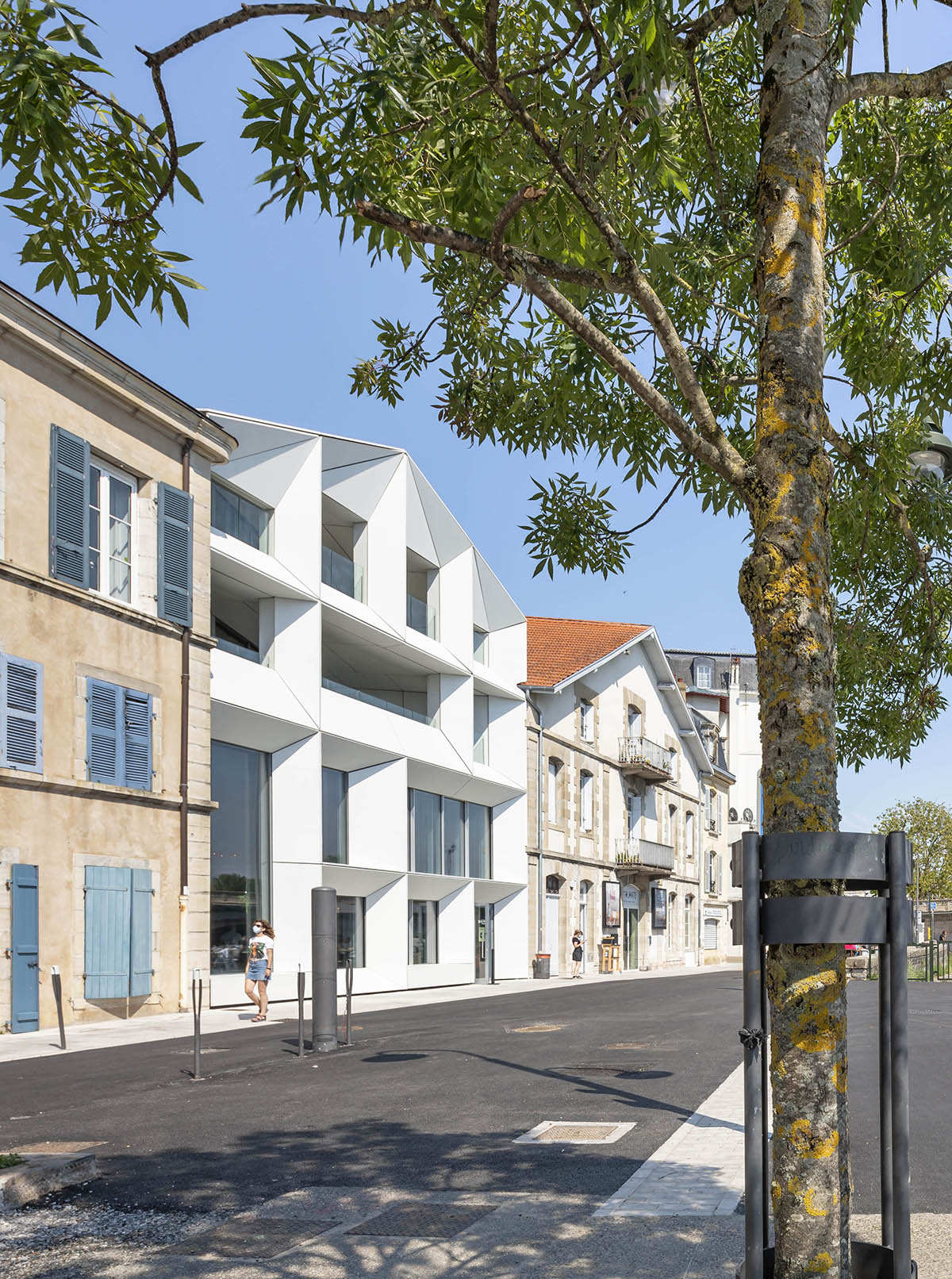
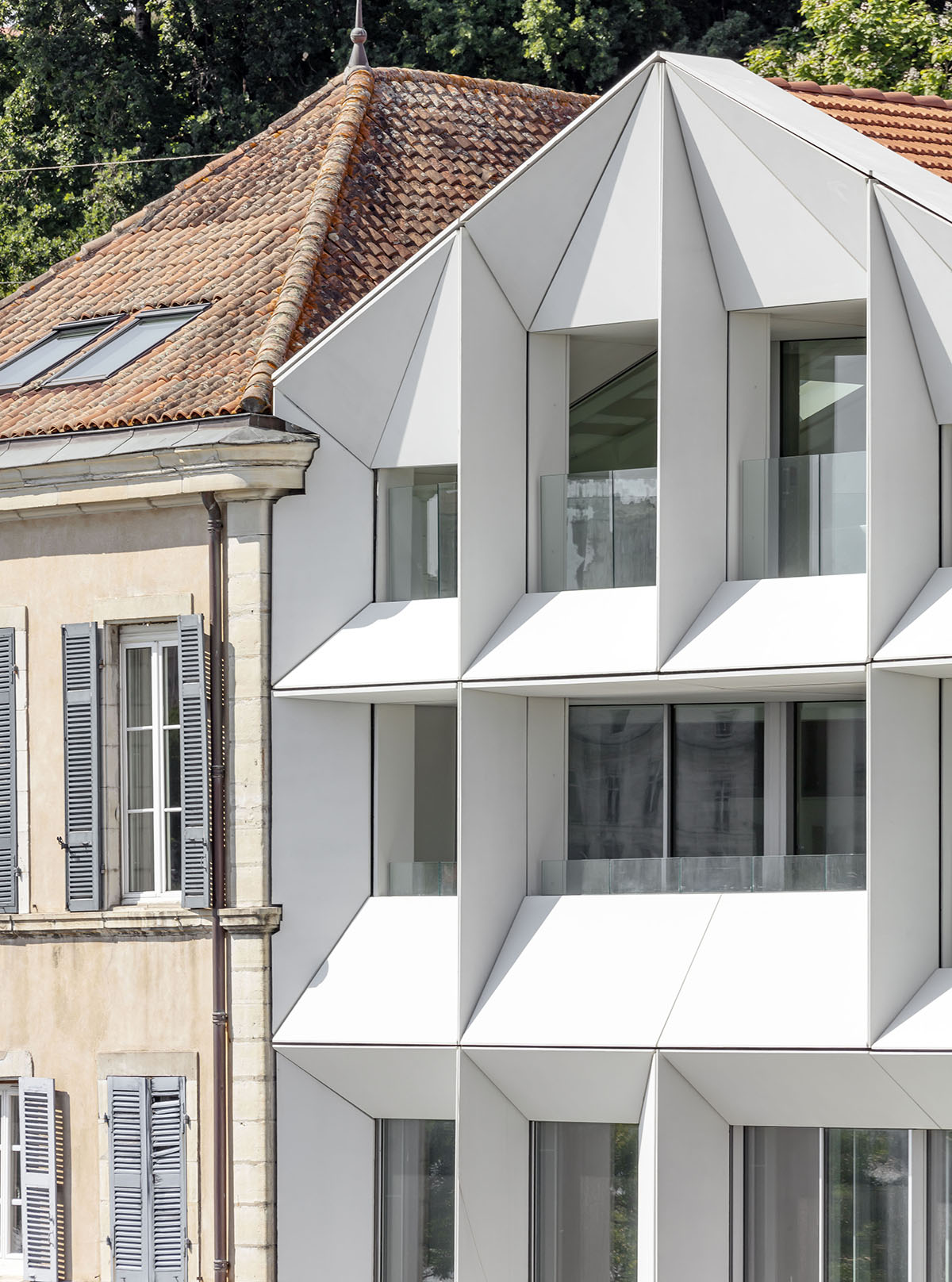
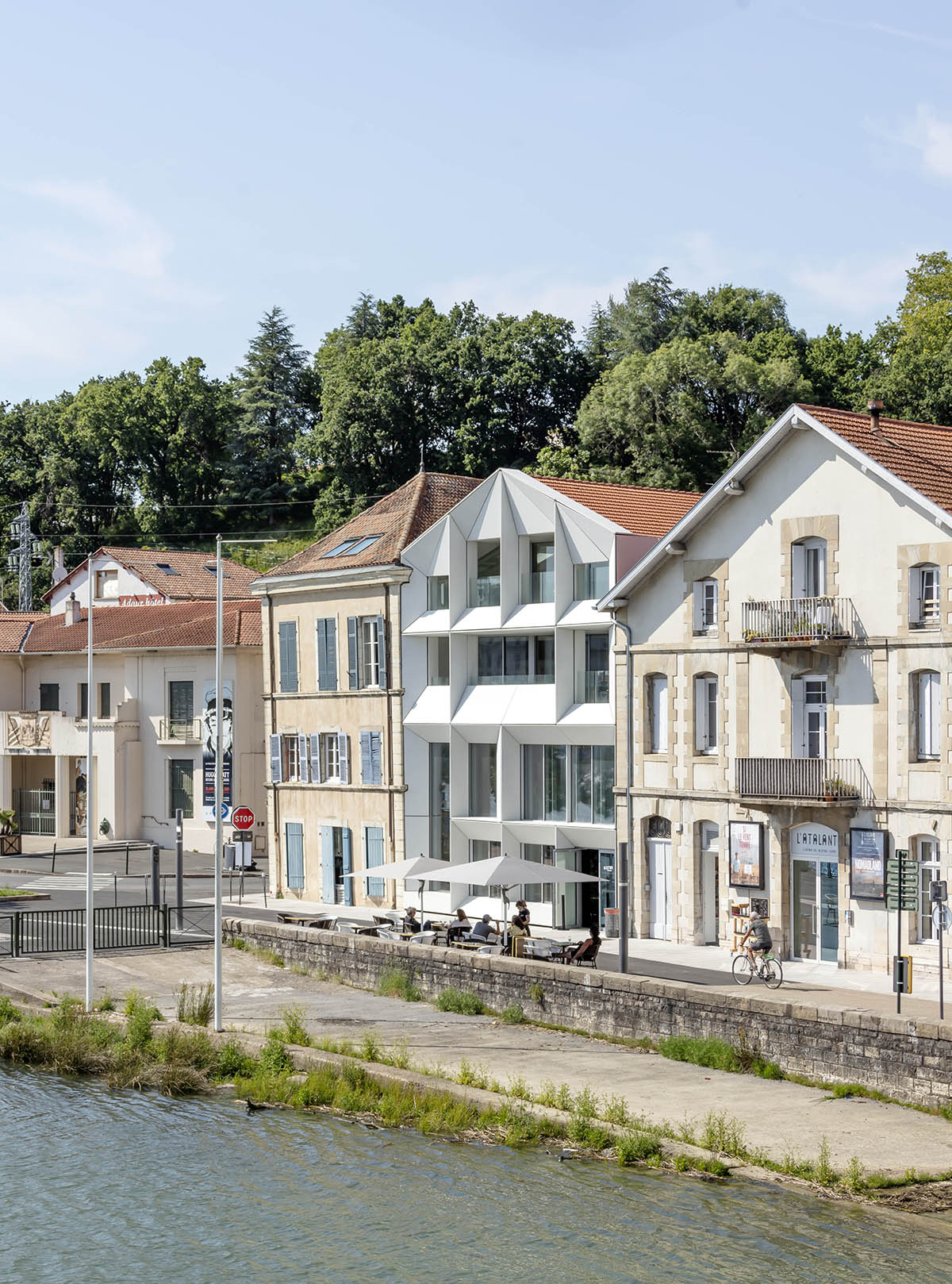
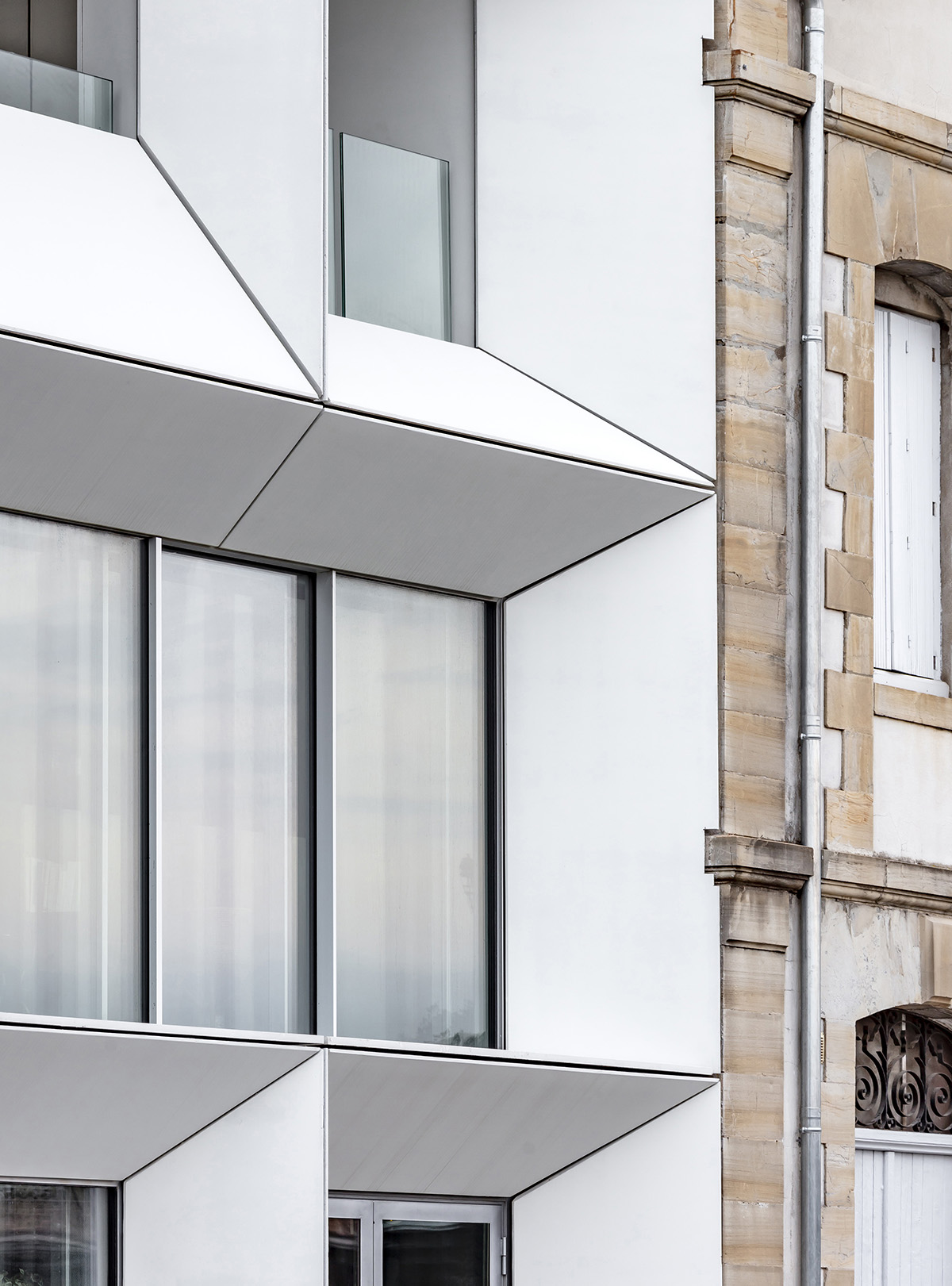
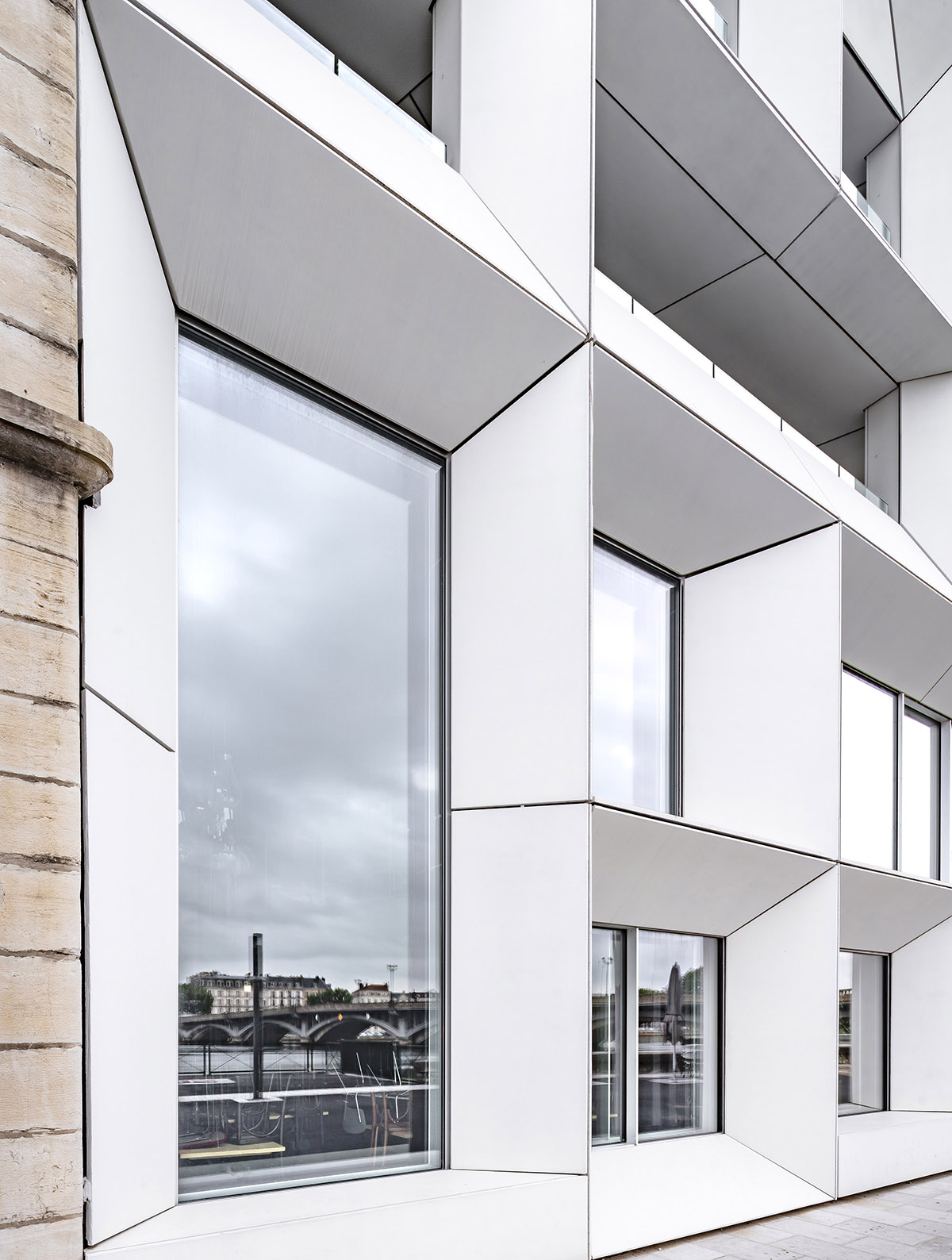
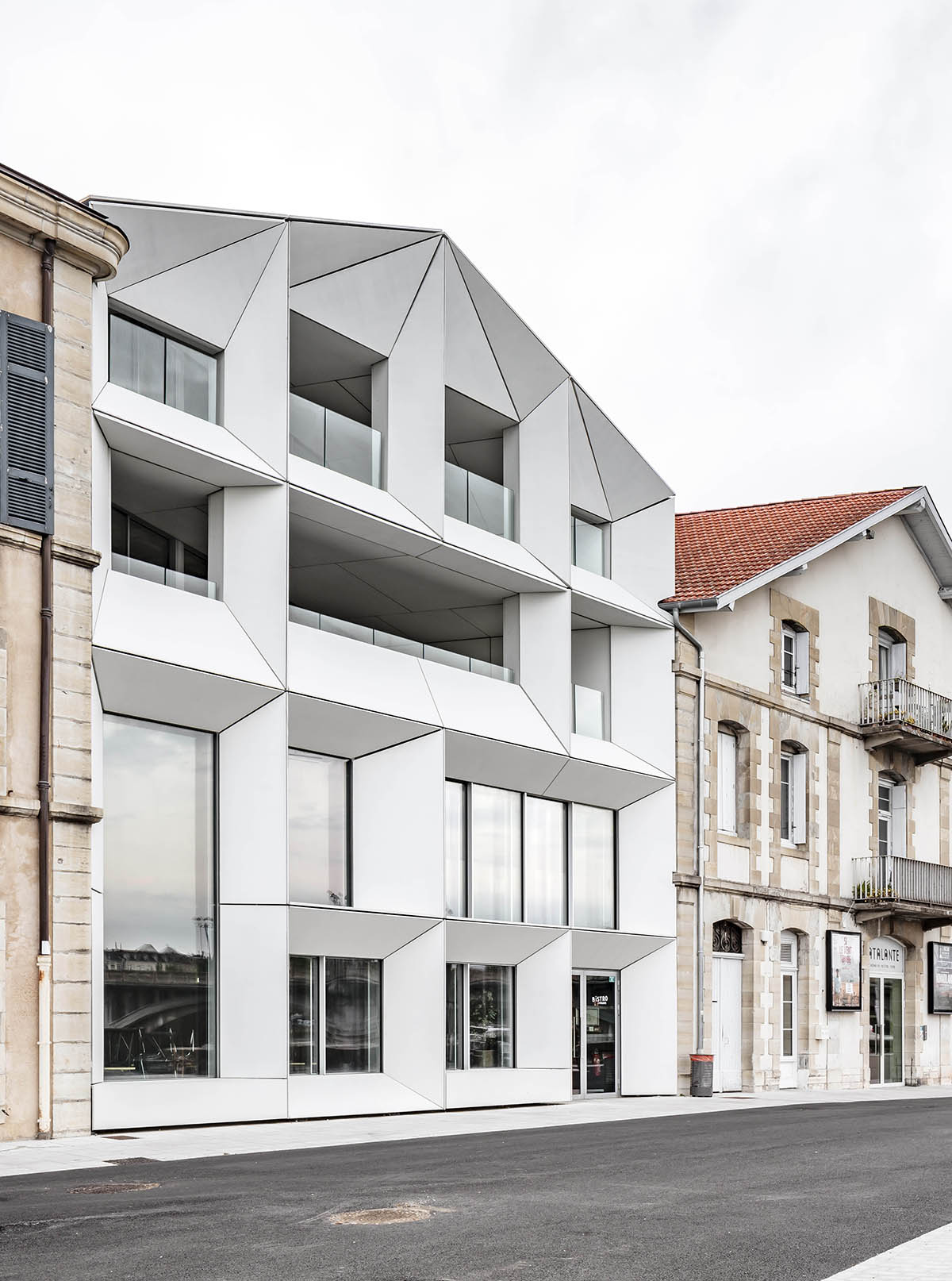
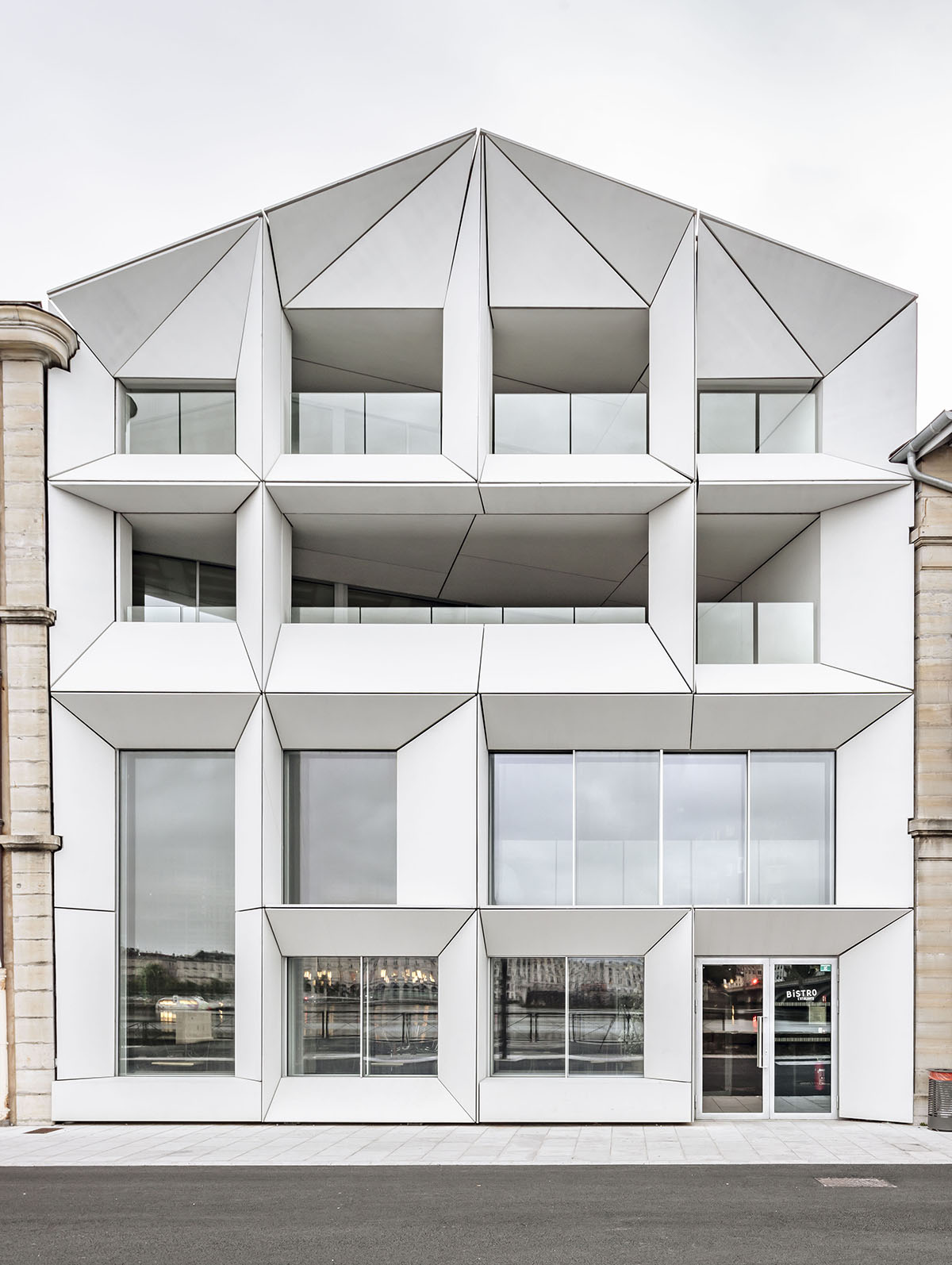
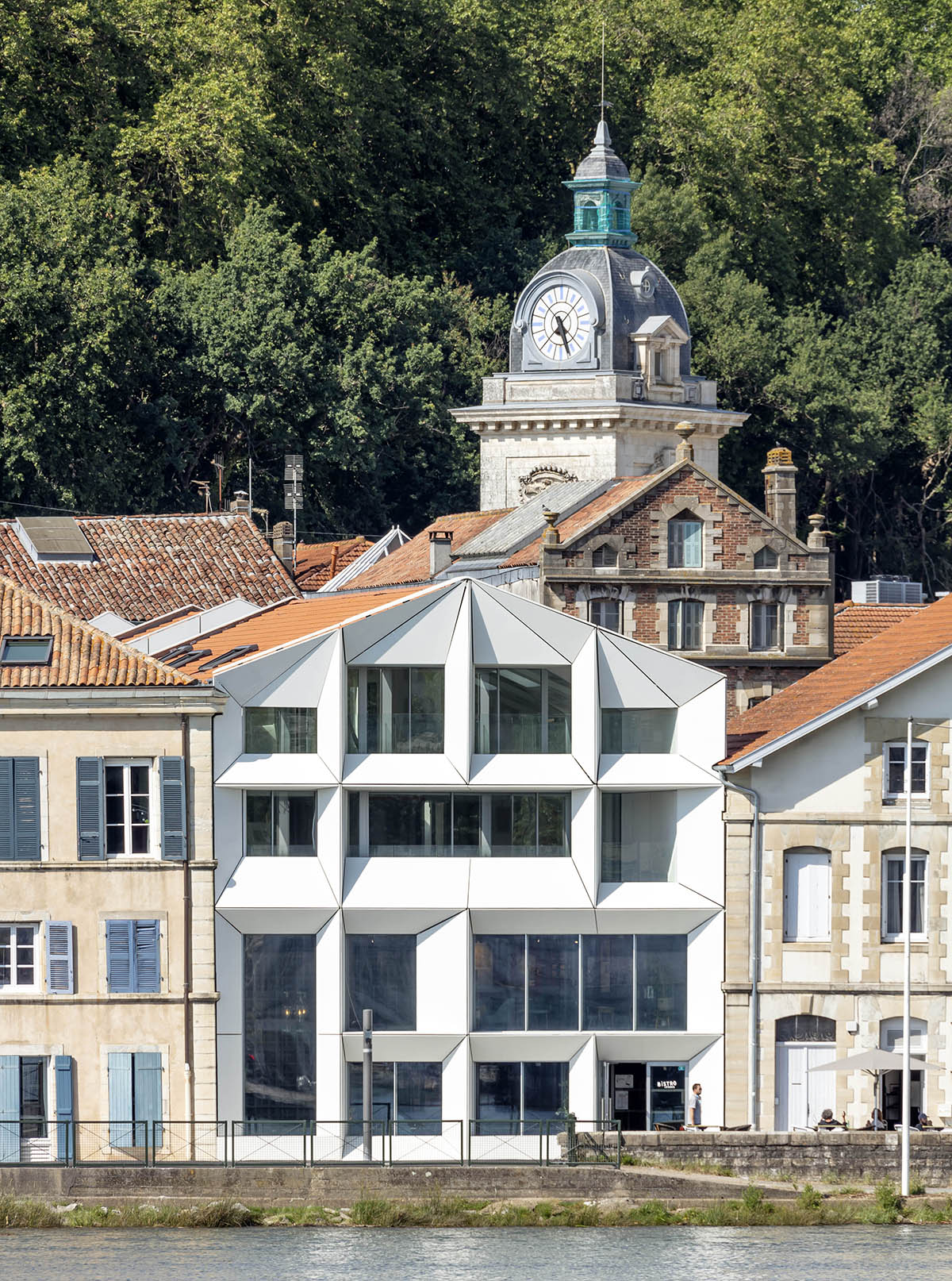
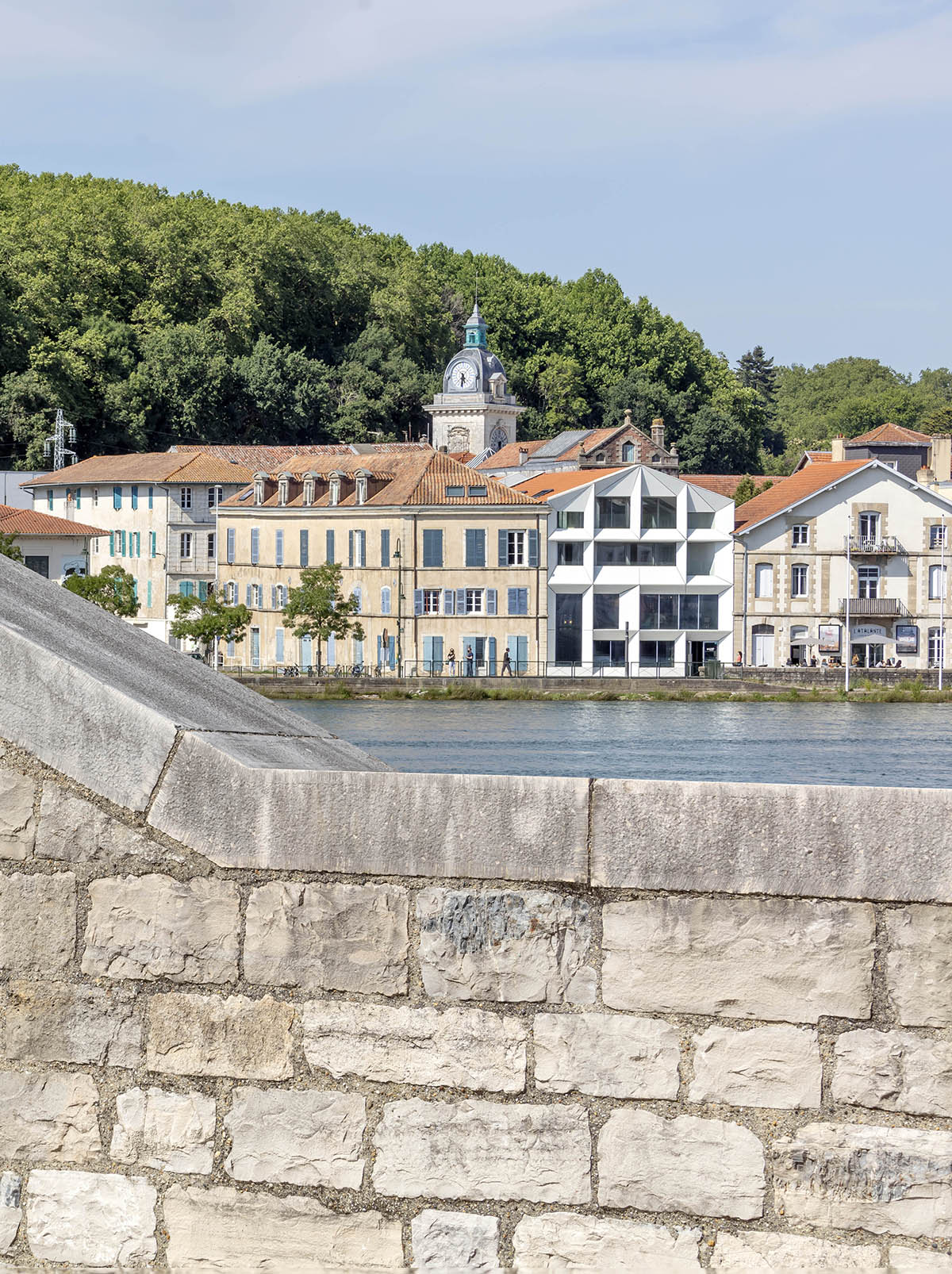
From inside this art-house, the landscape of the docks, the perspective of the bridge with its permanent mobility, the river and its waves and the historic city up opposite on the other bank are magnified urban sceneries. They are, underlined by the division of the openings and the orientations of the different points of view offered to the vi- sitors, giving free rein to their interpretations. Thus the fa- çade is made up of prismatic projecting volumes, created with light prefabricated elements, while the rear façade uses the same device, but in a lighter, more abbreviated way, like a short film… As Sylvie Larroque, co-director of L’Atalante, rightly said: «There is really an interaction between the outside and the inside. In front of this façade, we are already in a frame of mind of potential fiction with its screen-like windows. These notions of openness to the outside, of transparency, of visibility and of proximity to the river were really integrated into the initial construction project.
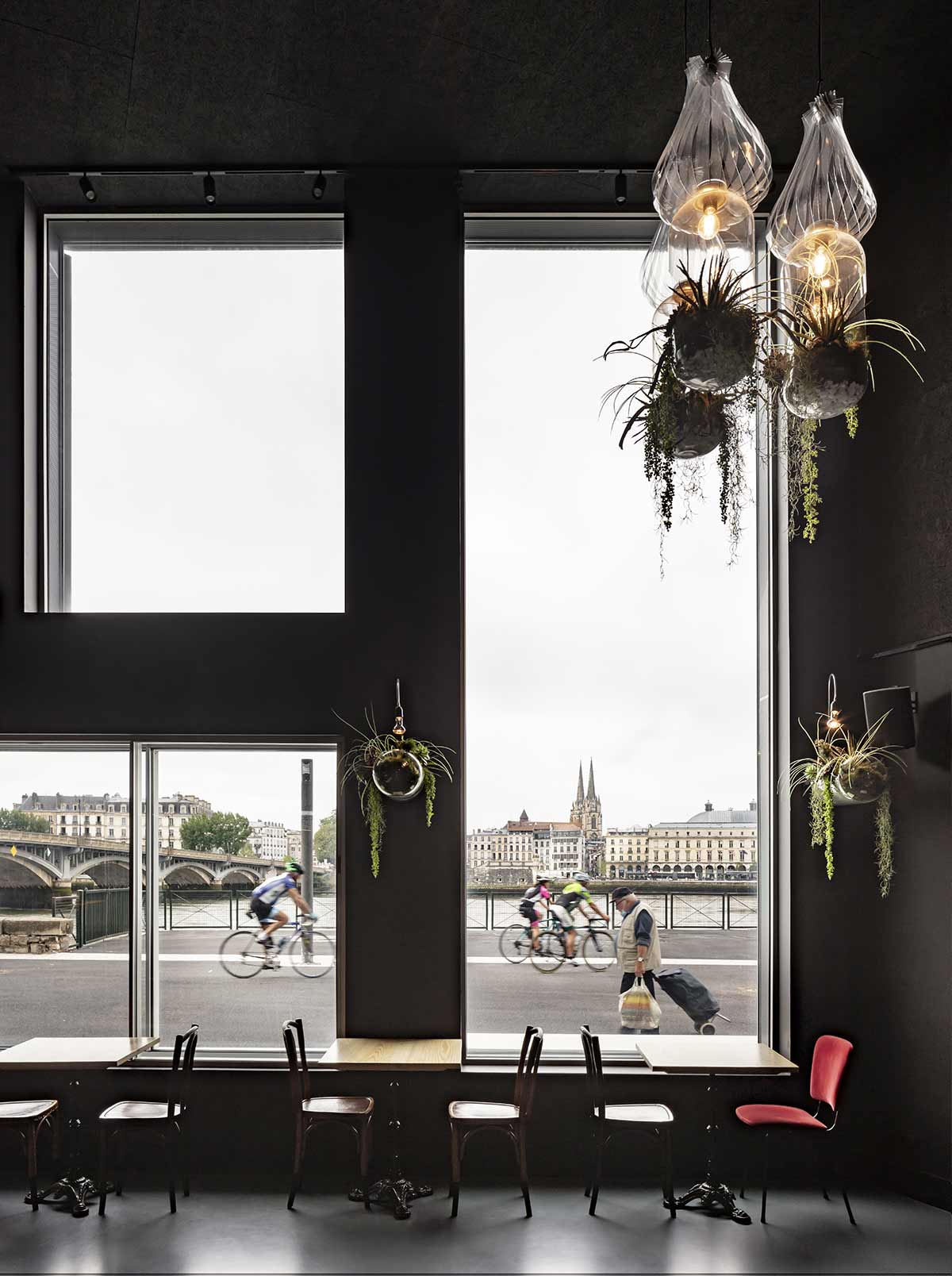
«THE CINEMA FACADE IS ESSENTIAL IN ENHANCING OUR VISIBILITY WITH ITS OPENINGS ONTO THE RIVER AND THIS UNIQUENESS WHICH MAKES IT VERY CINEMATIC-LIKE.»
SYLVIE LARROQUE, CO-DIRECTOR OF L’ATALANTE
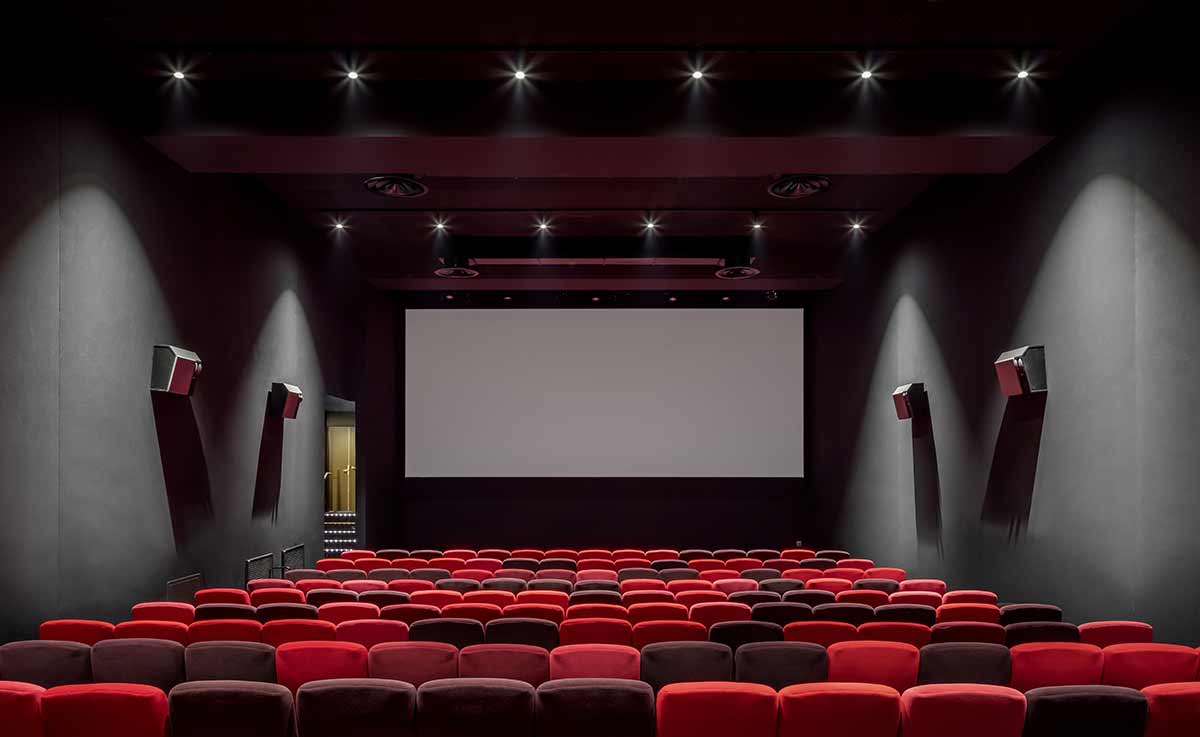
A COSY INTERIOR SPACE, DEDICATED TO PLEASURE AND INTERACTIONS
The project therefore consisted of building a new hall, a bar-restaurant and two flats negotiated as a dation for the owner of the land. The L’Atalante team was keen to create a place that was going to be lively.
Between the cinema reception area and the bar-restau- rant area, a system combines a wooden mesh on three levels, channelling the flows and allowing the installation of access control points to the cinemas. The internal acti- vities generate a great deal of sound, with the broadcas- ting of films and the music of the bar-restaurant concerts. We had to protect the neighbourhood, as well as the two new flats installed within the walls of L’Atalante and also the different spaces from one another. In-depth consul- tation with the acoustician on the future system was the- refore essential, especially as we had to combine these constraints with the site’s classification as a level 3 seis- mic zone, that being the most restrictive.
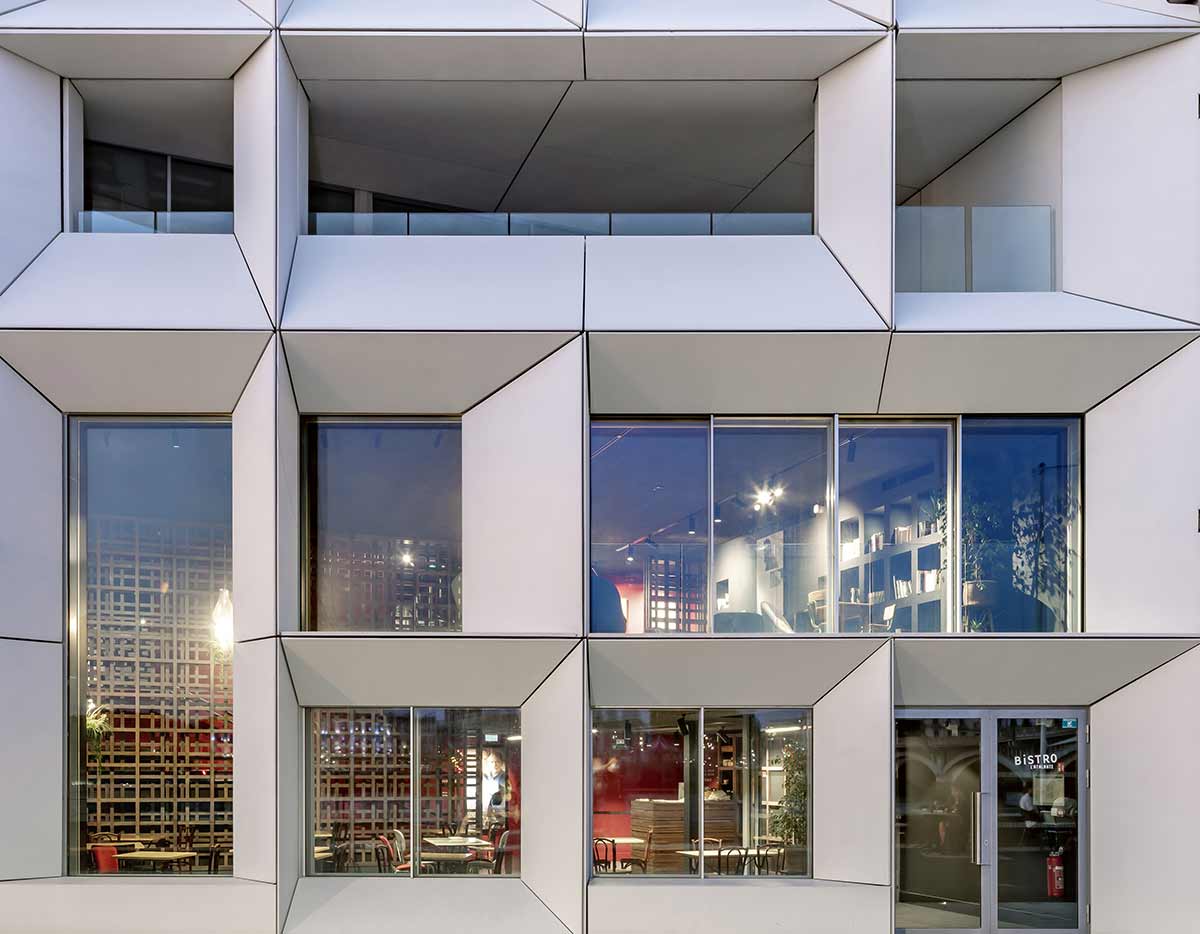
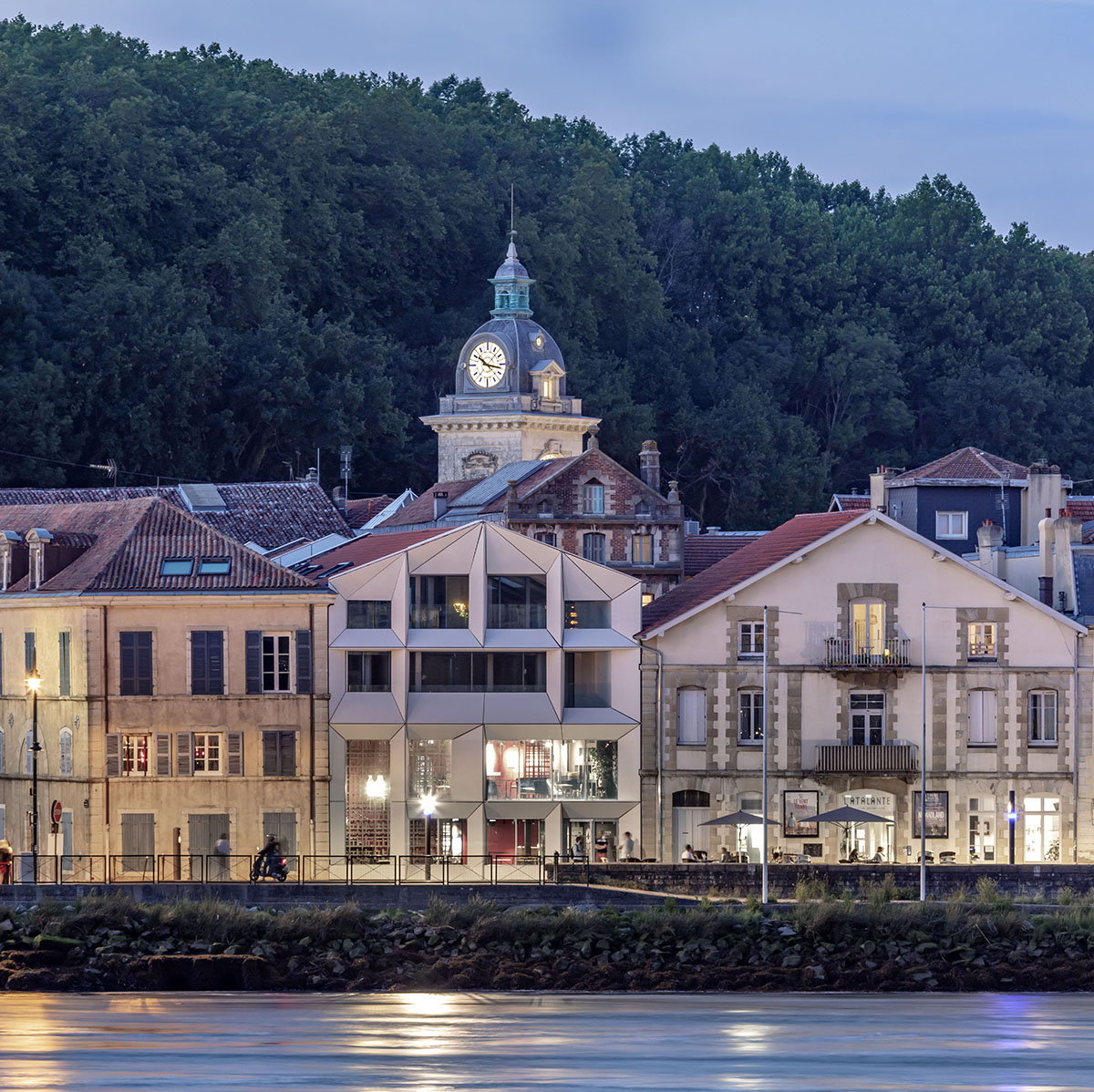
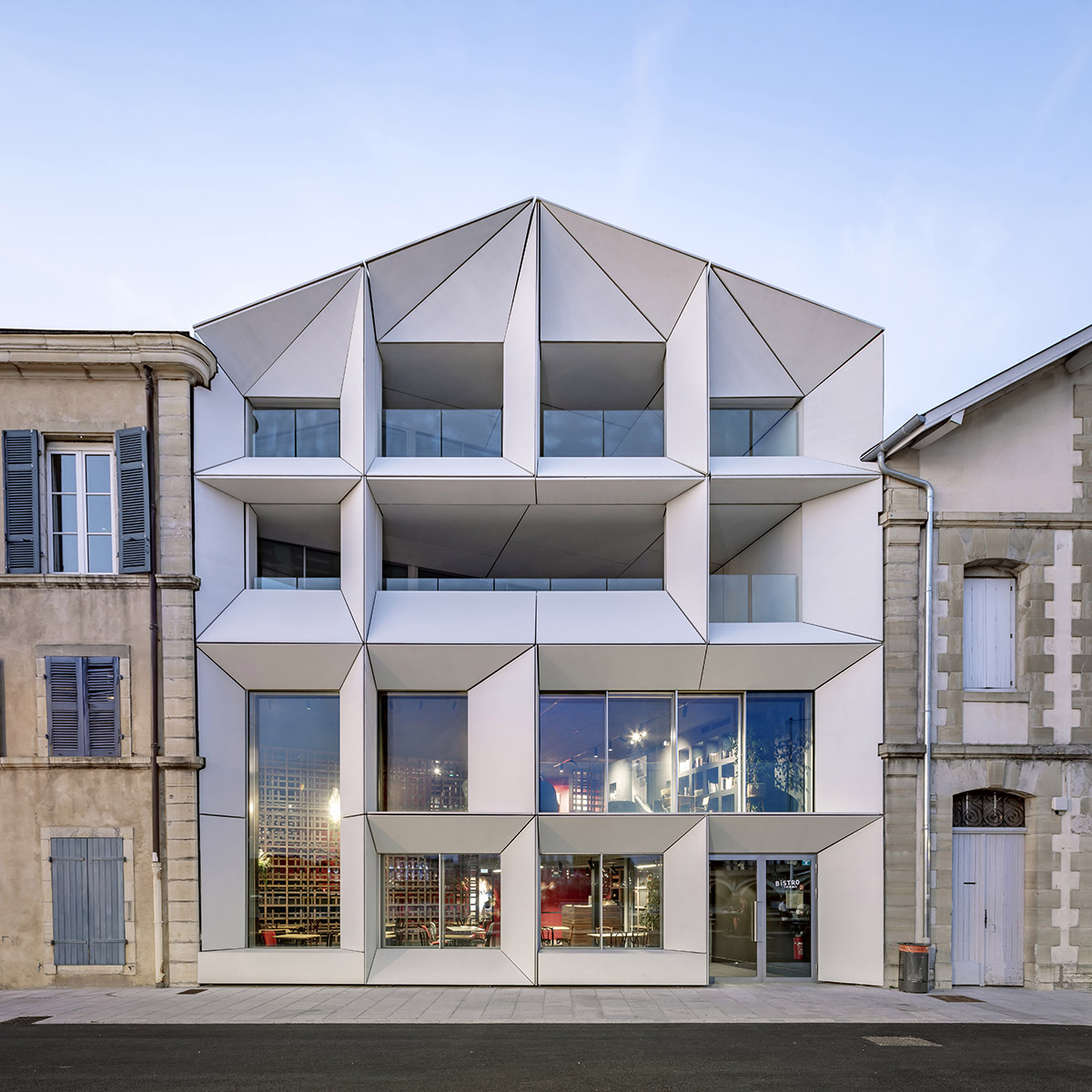
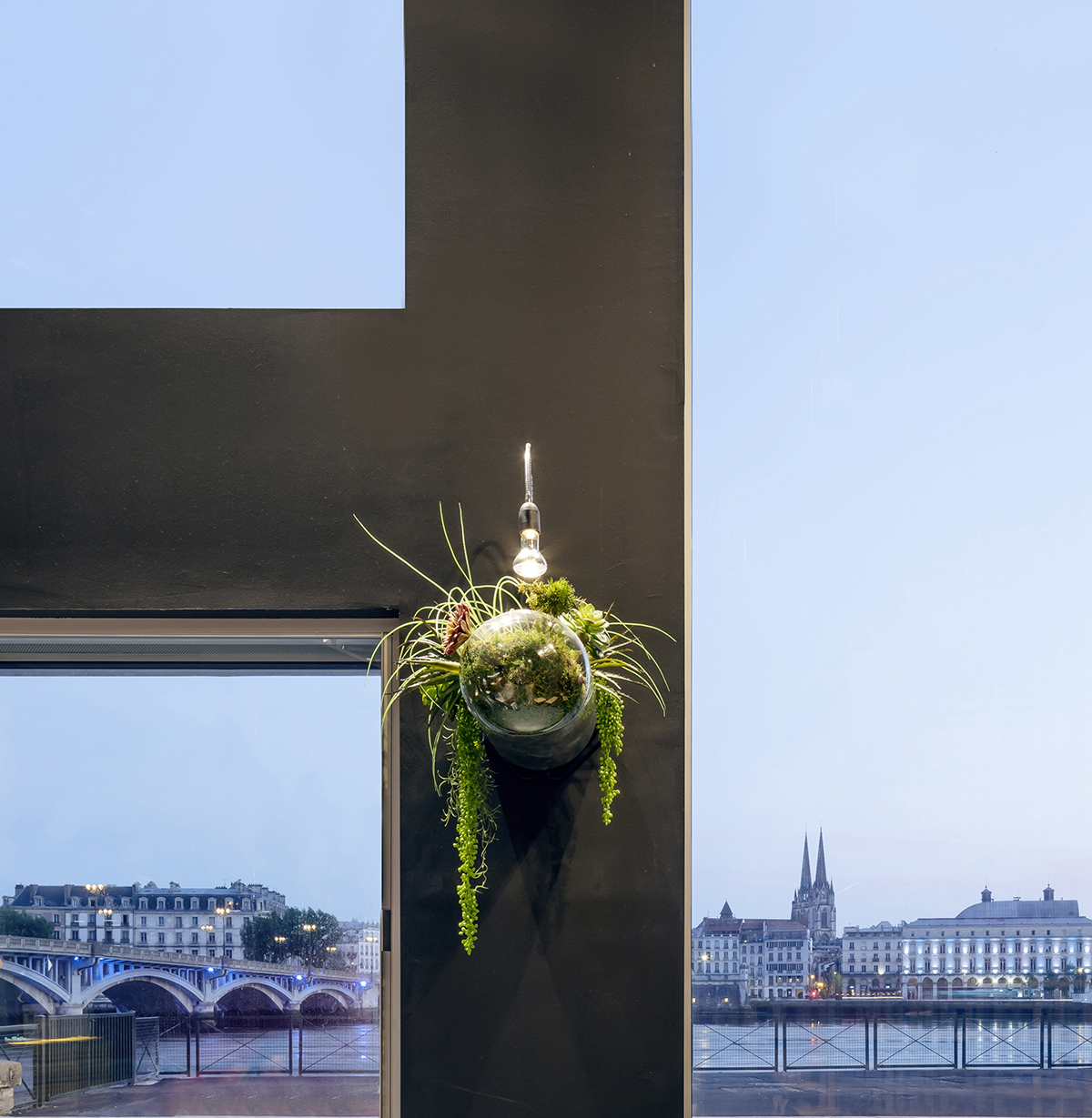
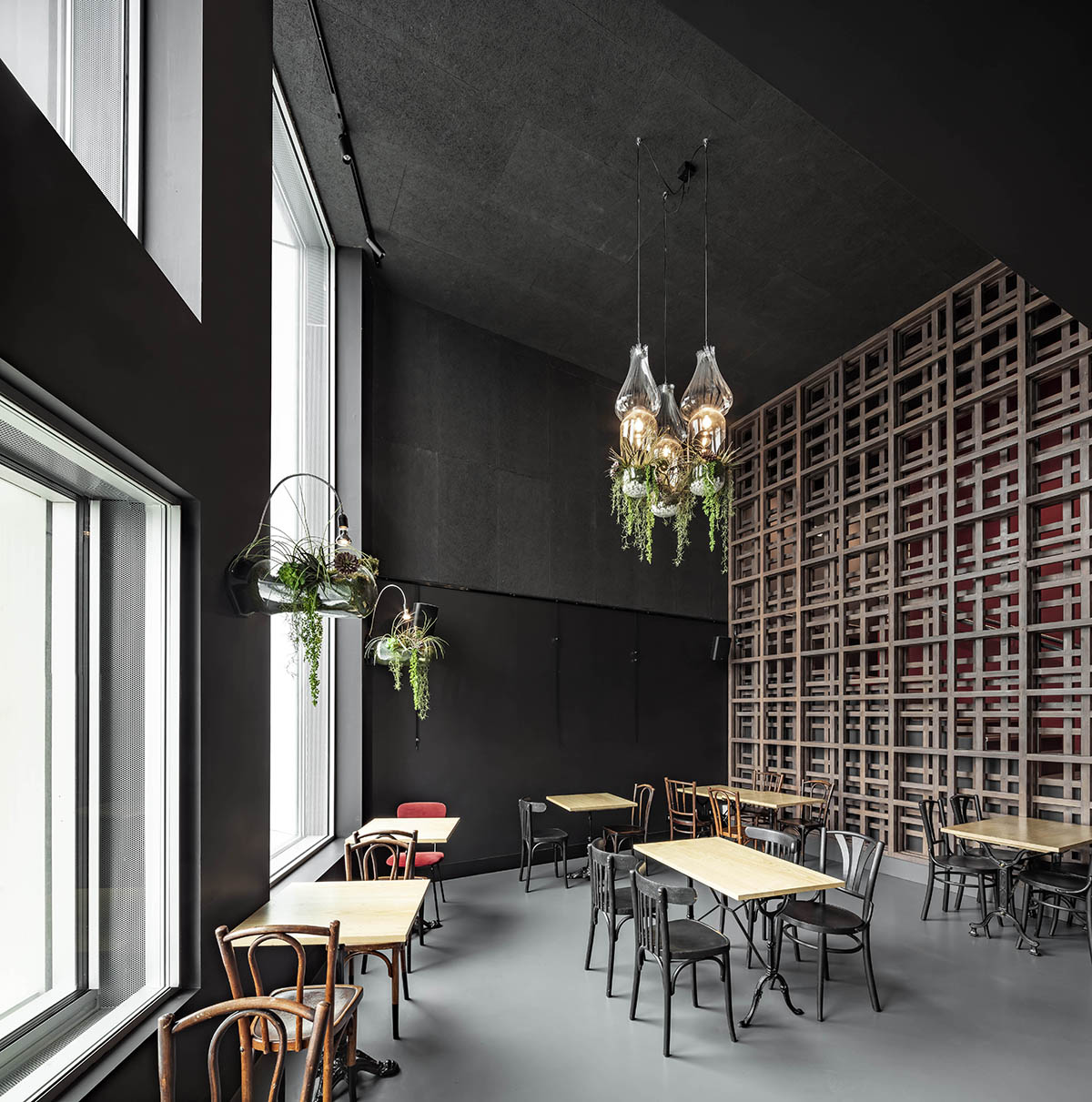
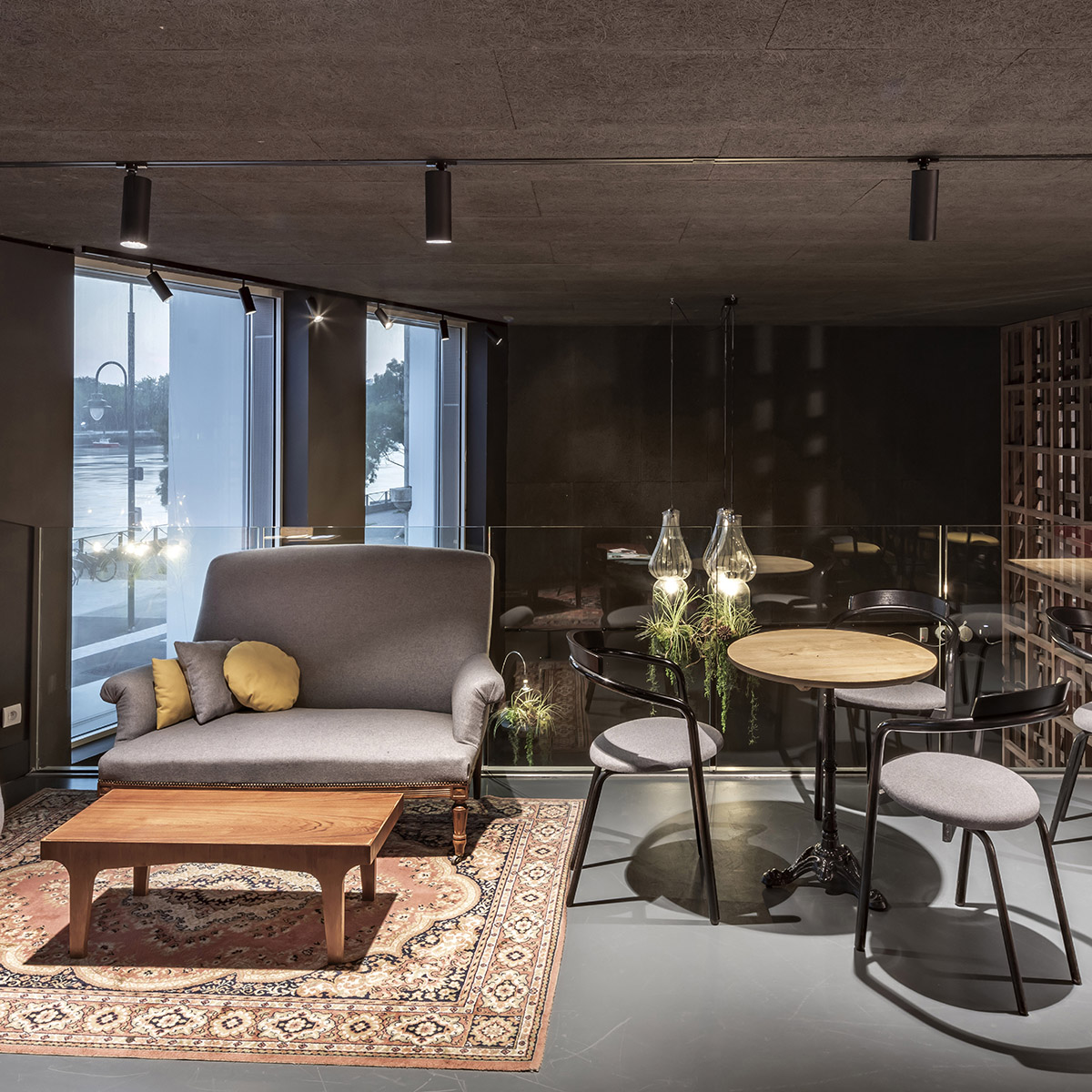
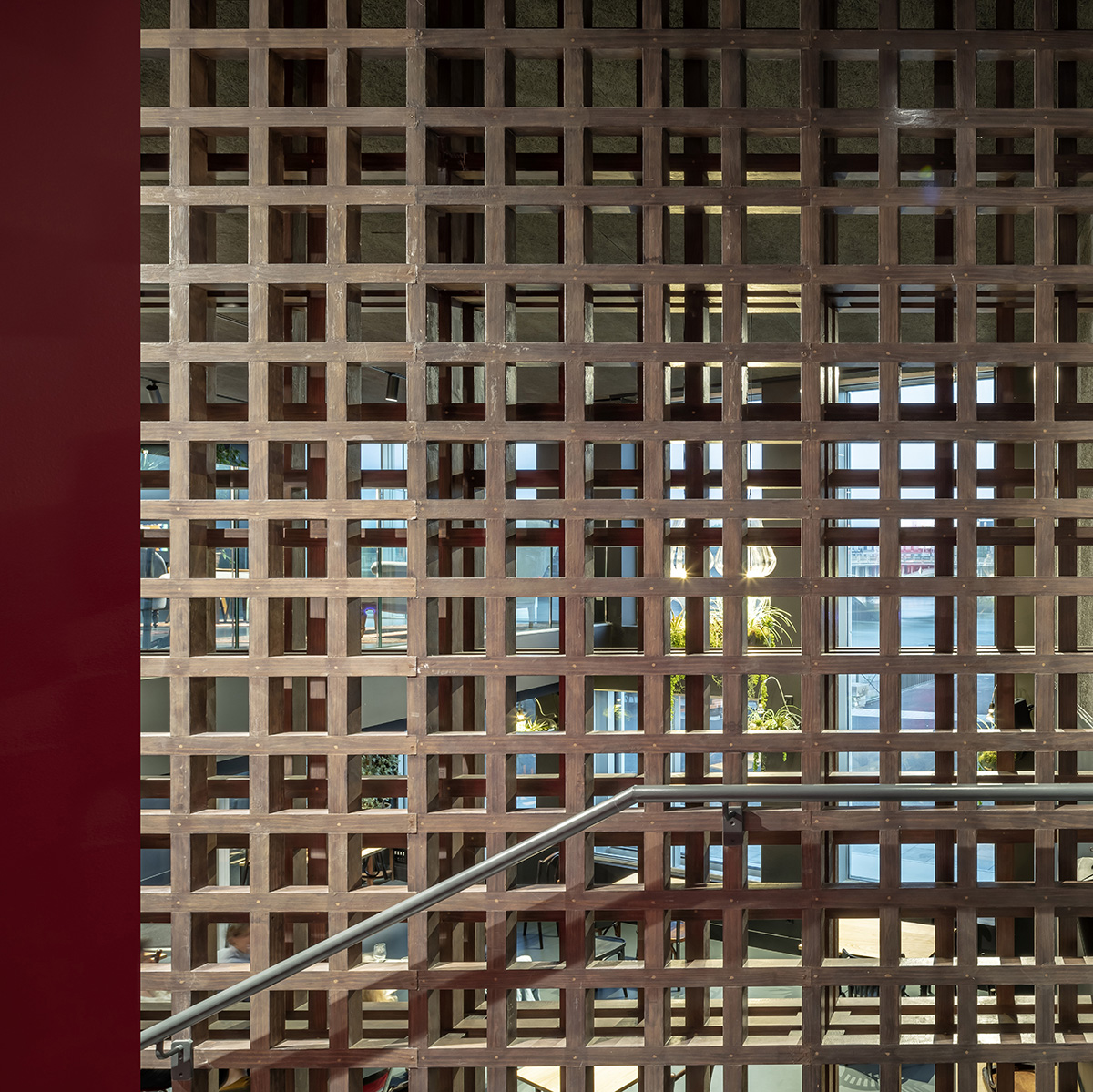
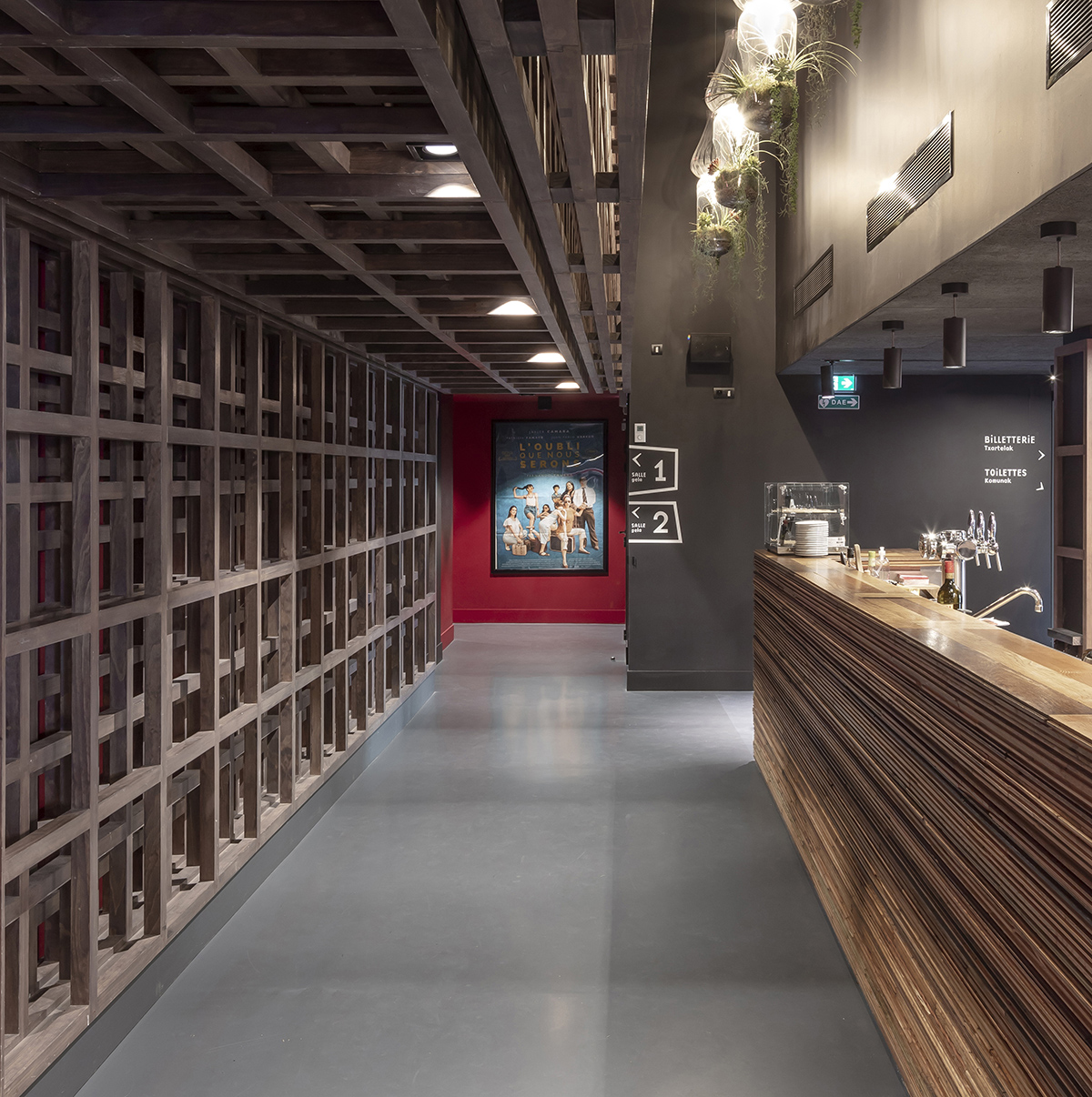
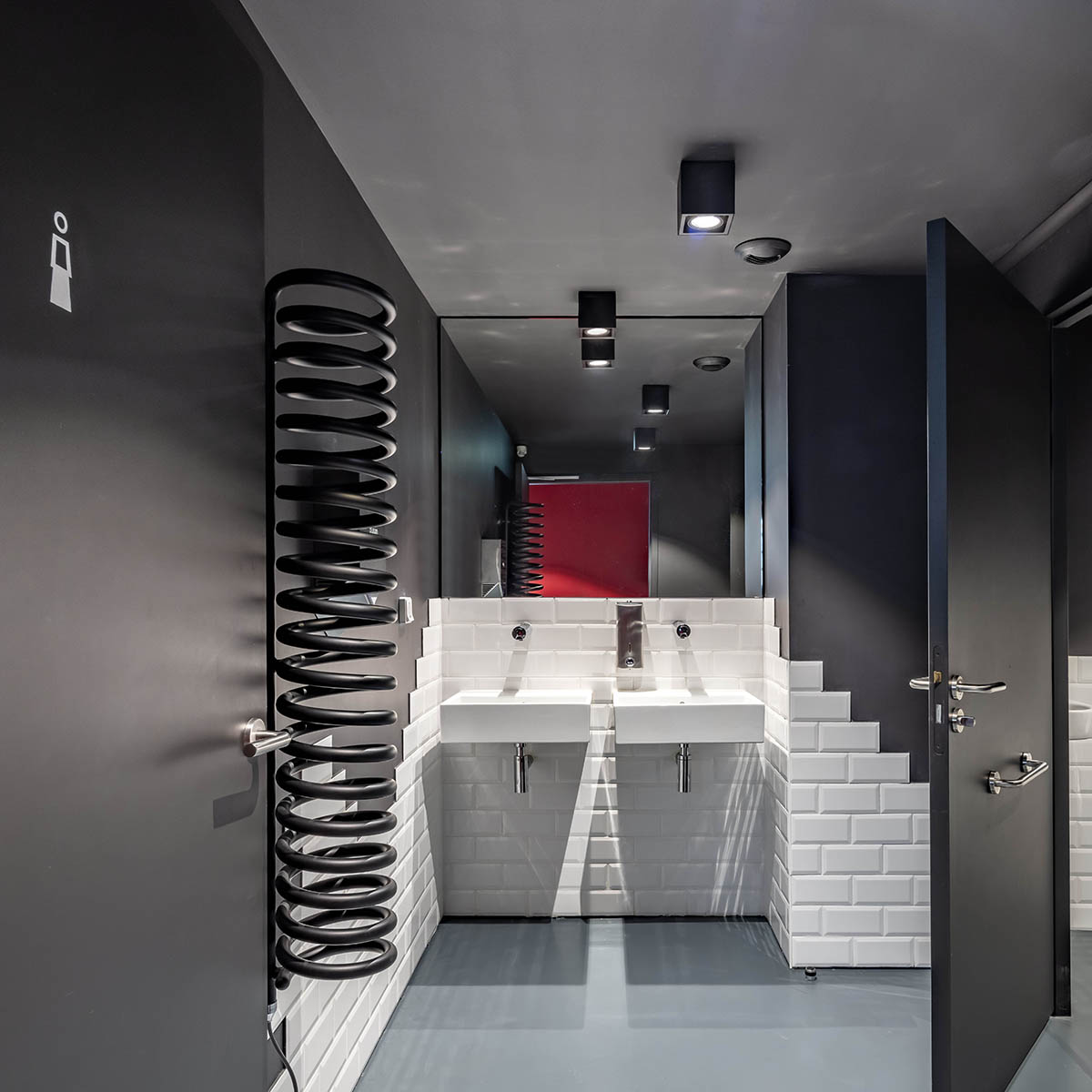
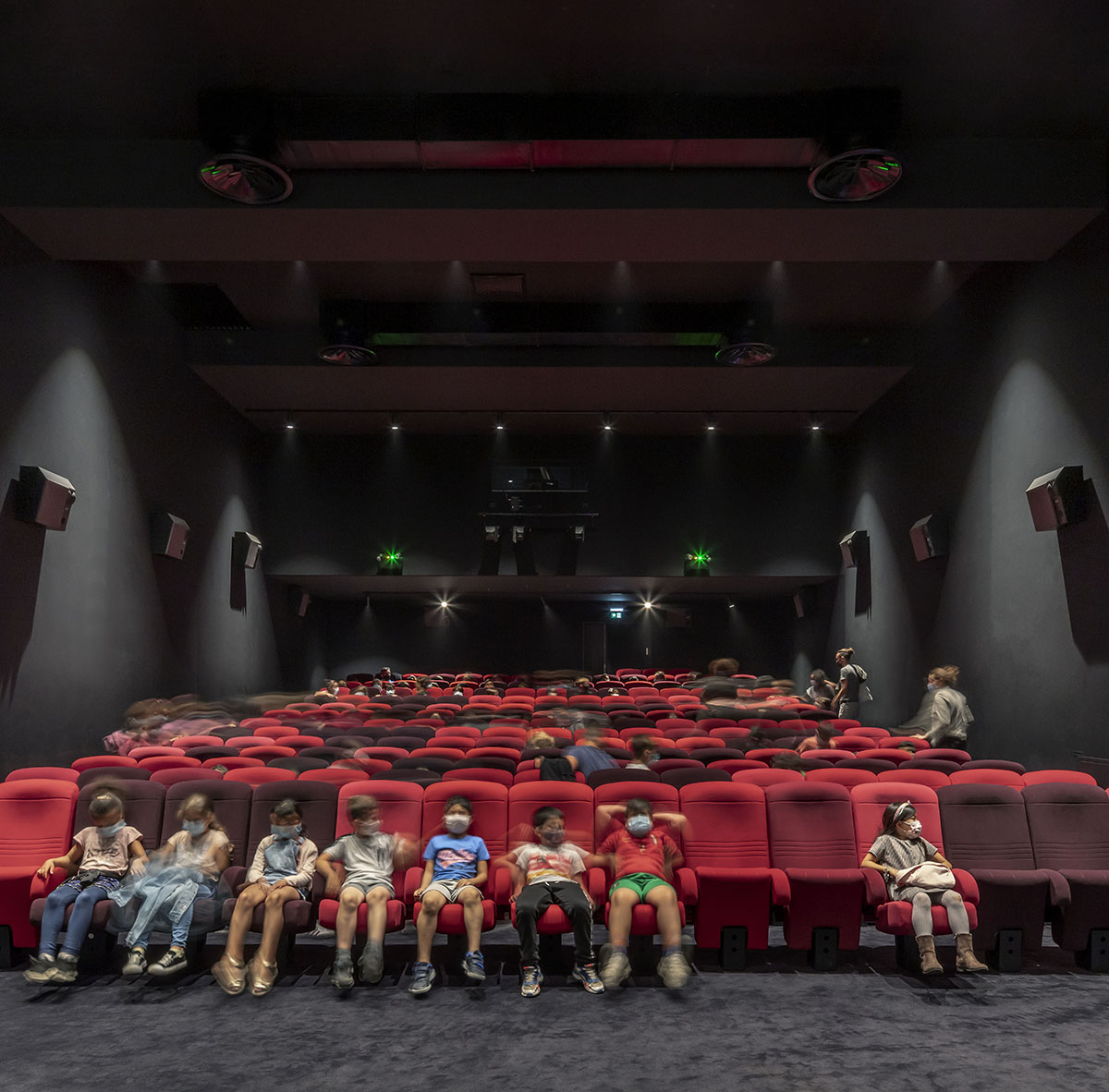
The transversal bar-restaurant forms the link between the existing transformed spaces and the extension. It has a strategic function. It consists of a very long woo- den counter with a pre-existing oak floor. The light atmosphere tends to reproduce the effects produced by the projection of a film. The glasses and bottles that are stored there contribute to amplify the play of light, for an even warmer and more welcoming atmosphere. Here, the view of the river is breathtaking. You feel that you are altogether a spectator and an actor, because as I wrote above, you can be seen from the outside… Thus the ci- nema and music bar-restaurant rooms are designed as airtight boxes and steps are taken (there is no direct ope- ning on the street side) to avoid any sound leaks. Acous- tic lining and independent double walls, double frames, uncoupled from the structure, as well as floors and their independently treated slabs were recommended. There are also a filtering of very low frequencies, dimensioned wall devices, and acoustic locks for all exits. Long baffle silencers and fresh air and exhaust intakes were installed and oriented appropriately. A mezzanine overlooks the li- ving area where food and drink are served and where the public can relax. It is a multi-purpose space for readings, debates and exhibitions, and can accommodate school groups for the mediation of cinematographic art…
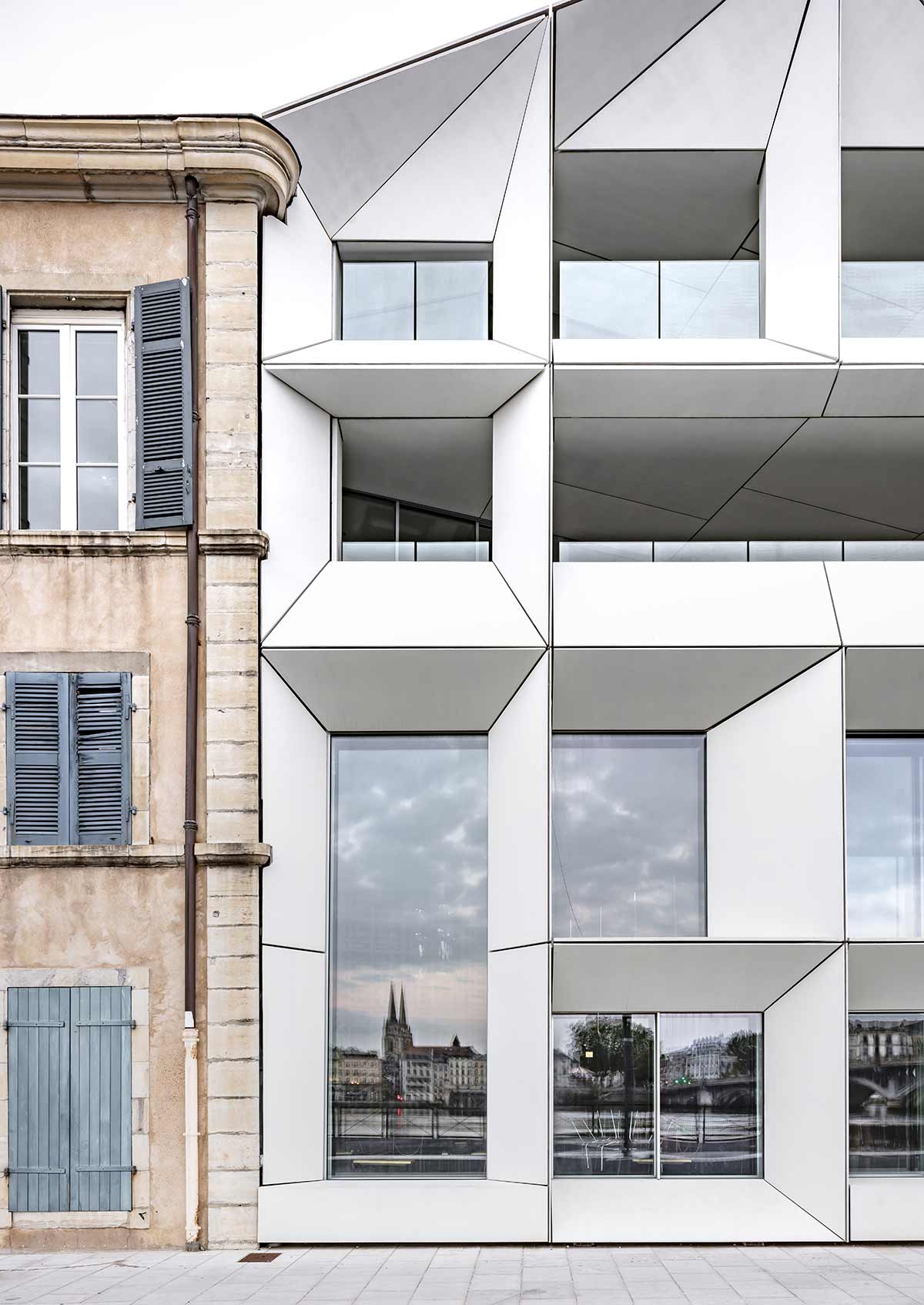
« SPACE AND TIME ARE THE FRAMEWORK WITHIN WHICH THE MIND IS FORCED TO BUILD ITS EXPERIENCE OF REALITY. »
EMMANUEL KANT
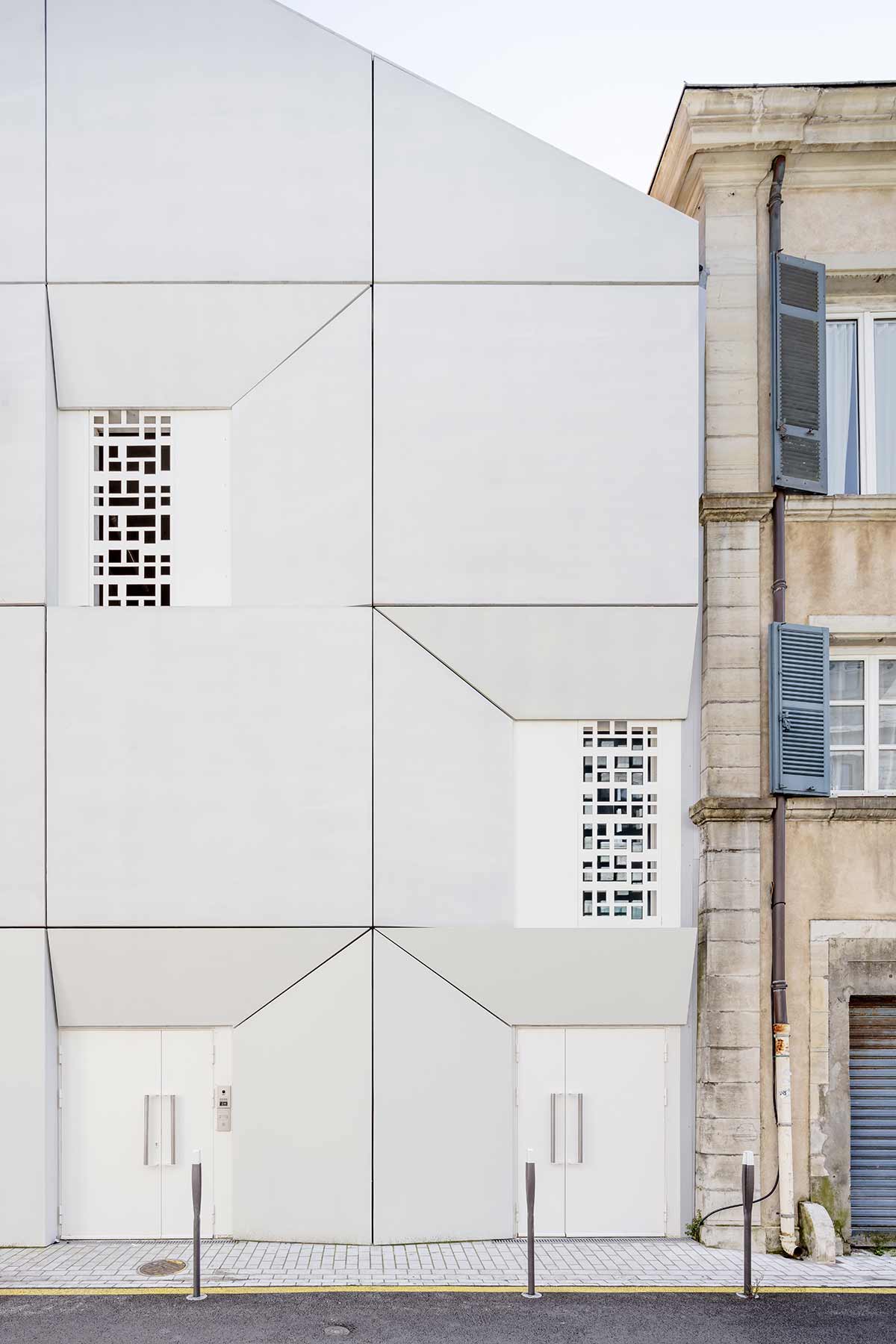
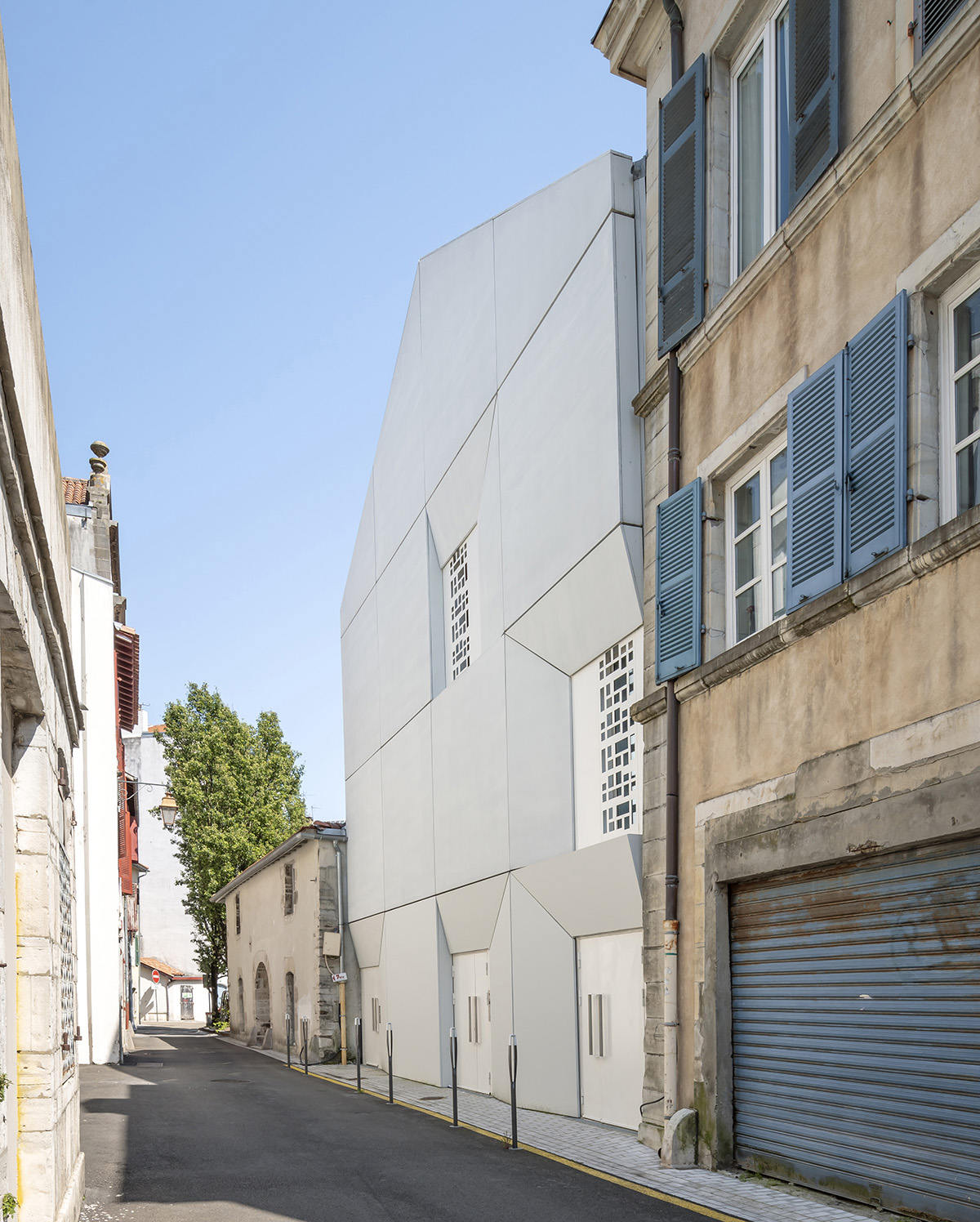
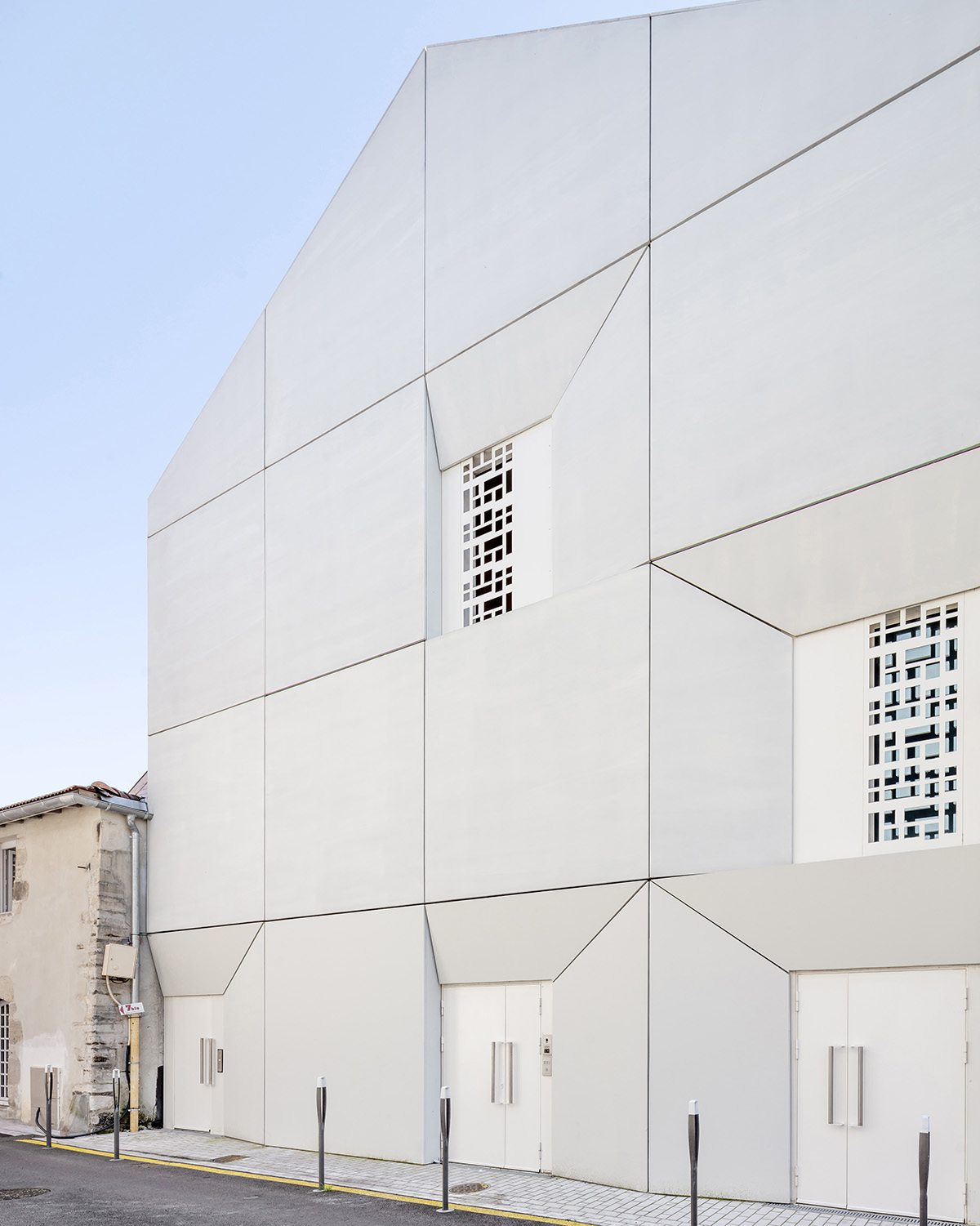
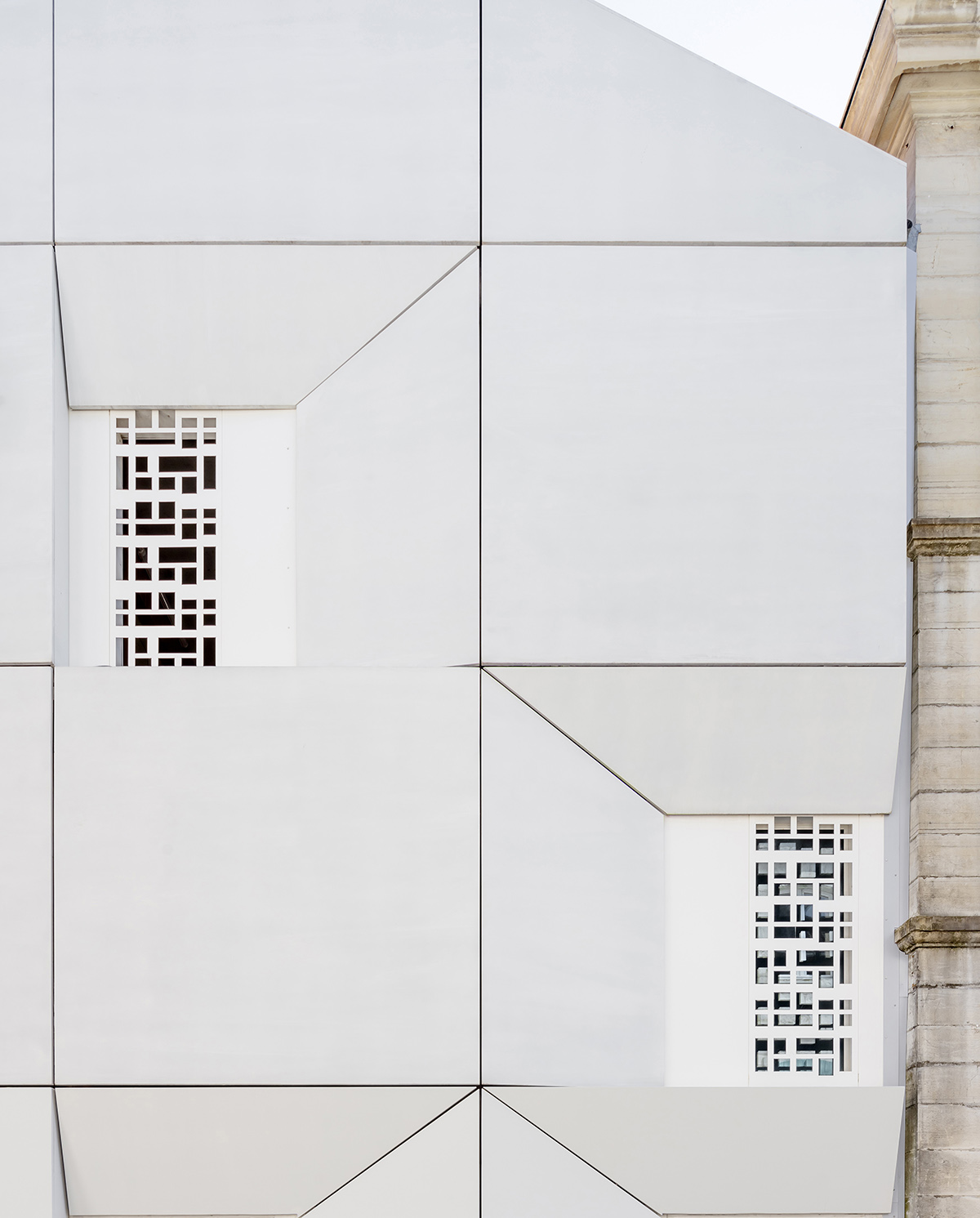
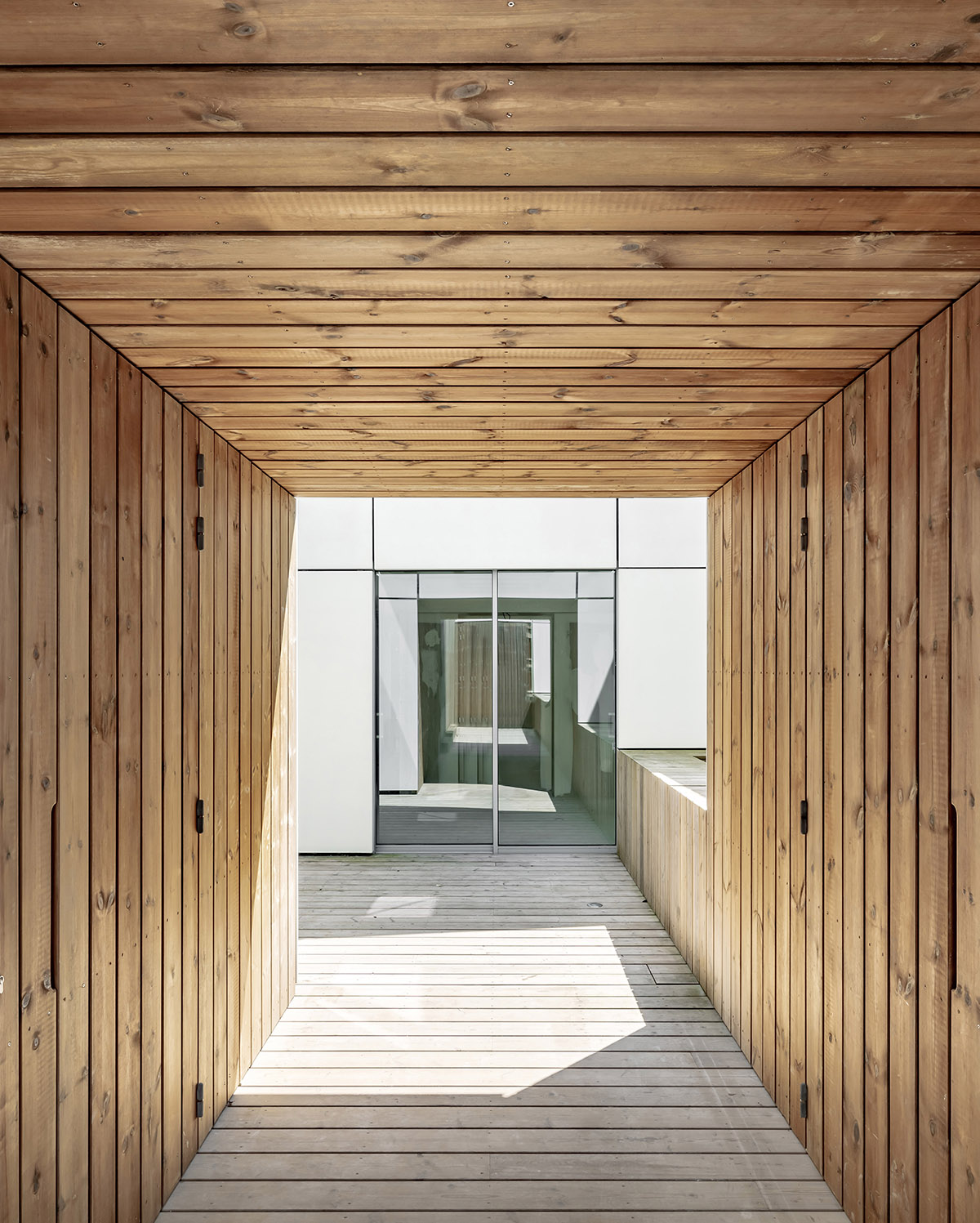
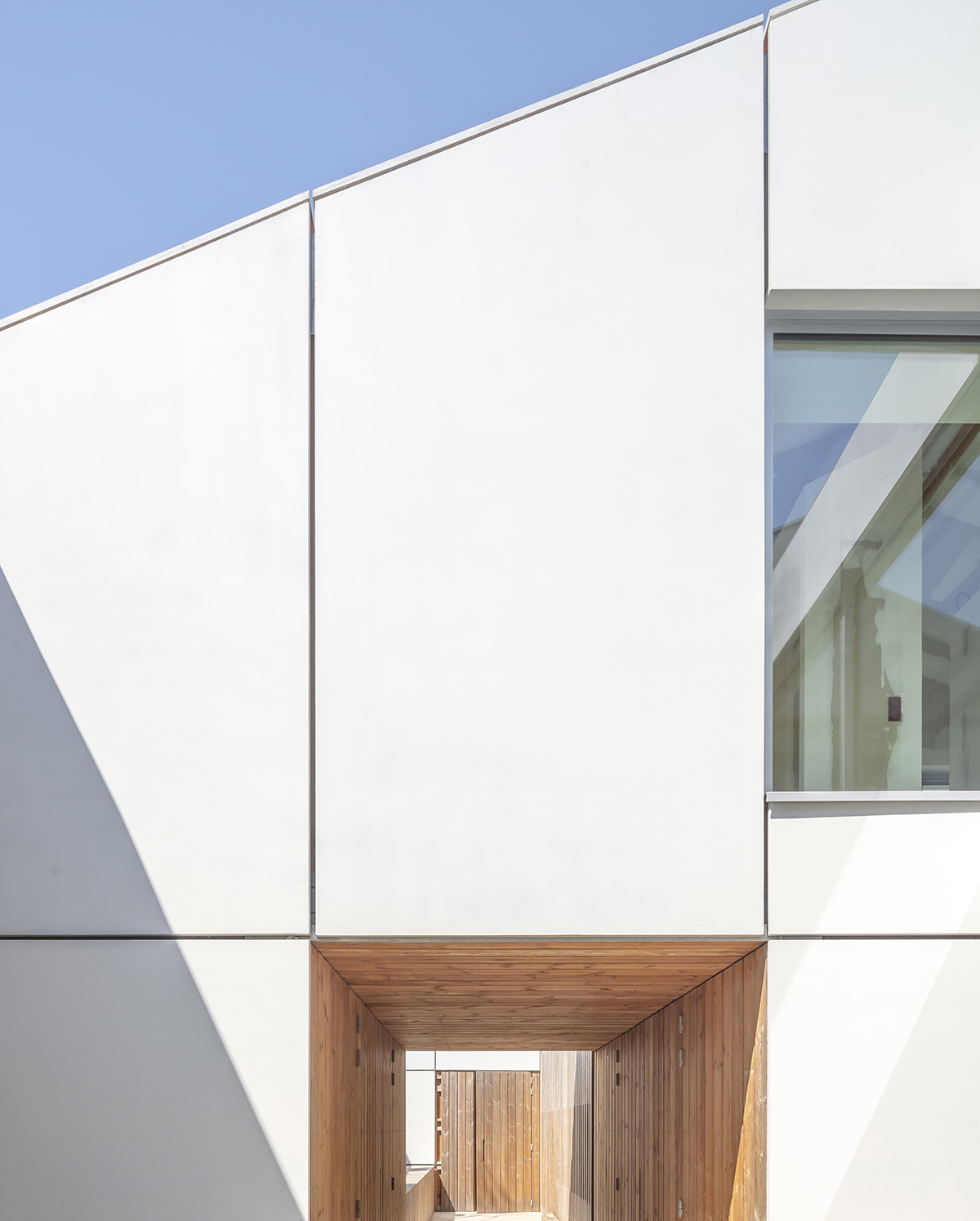


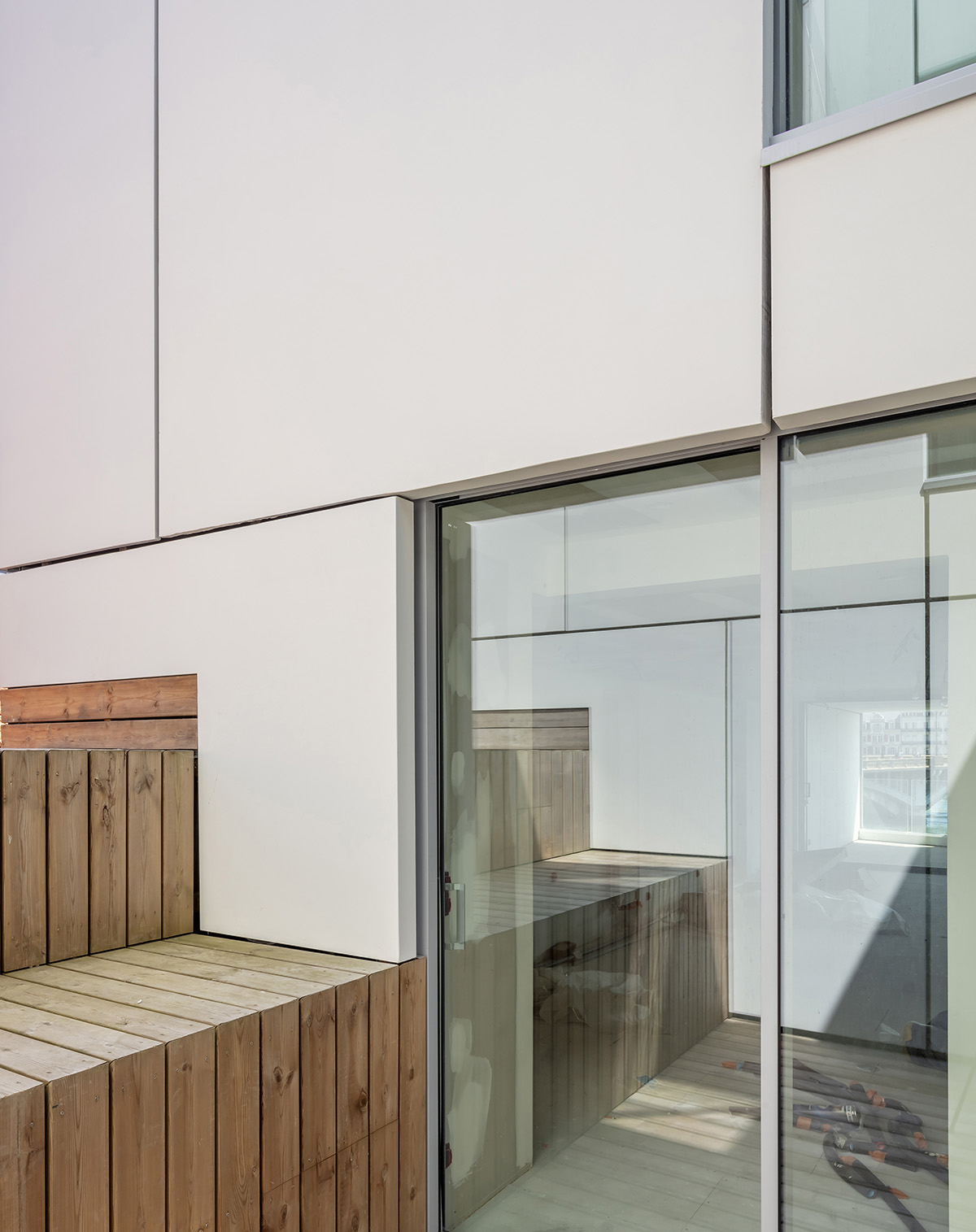
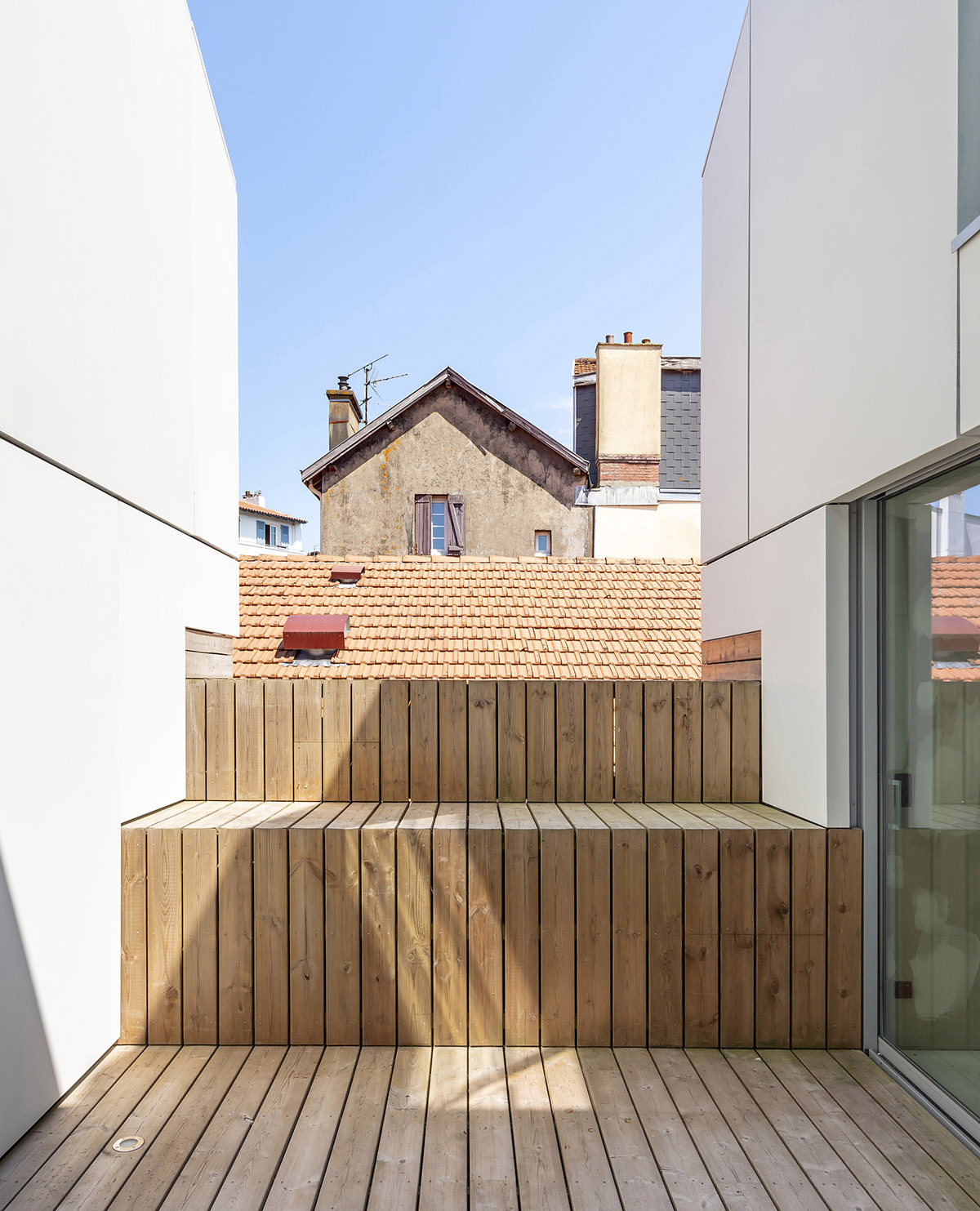
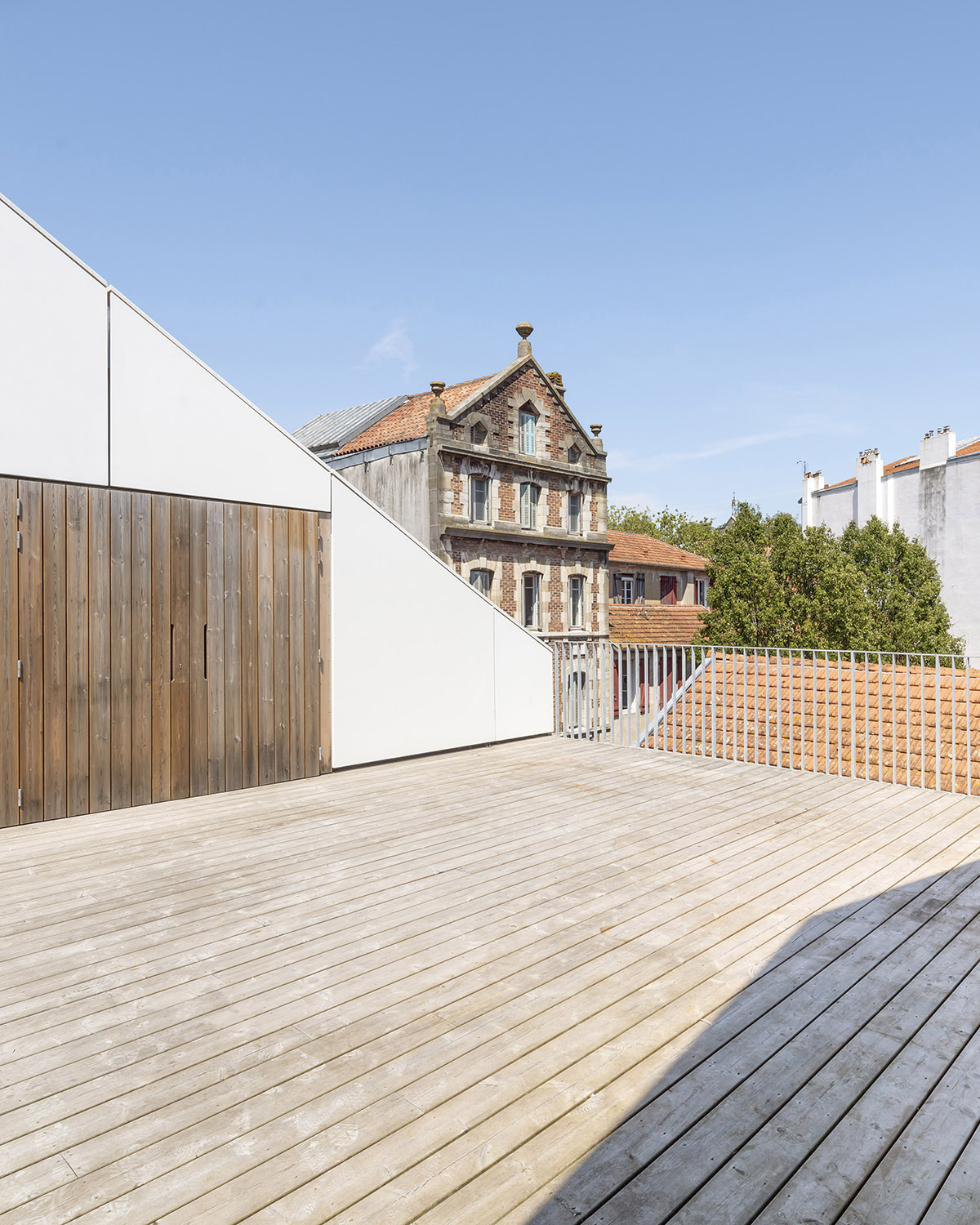

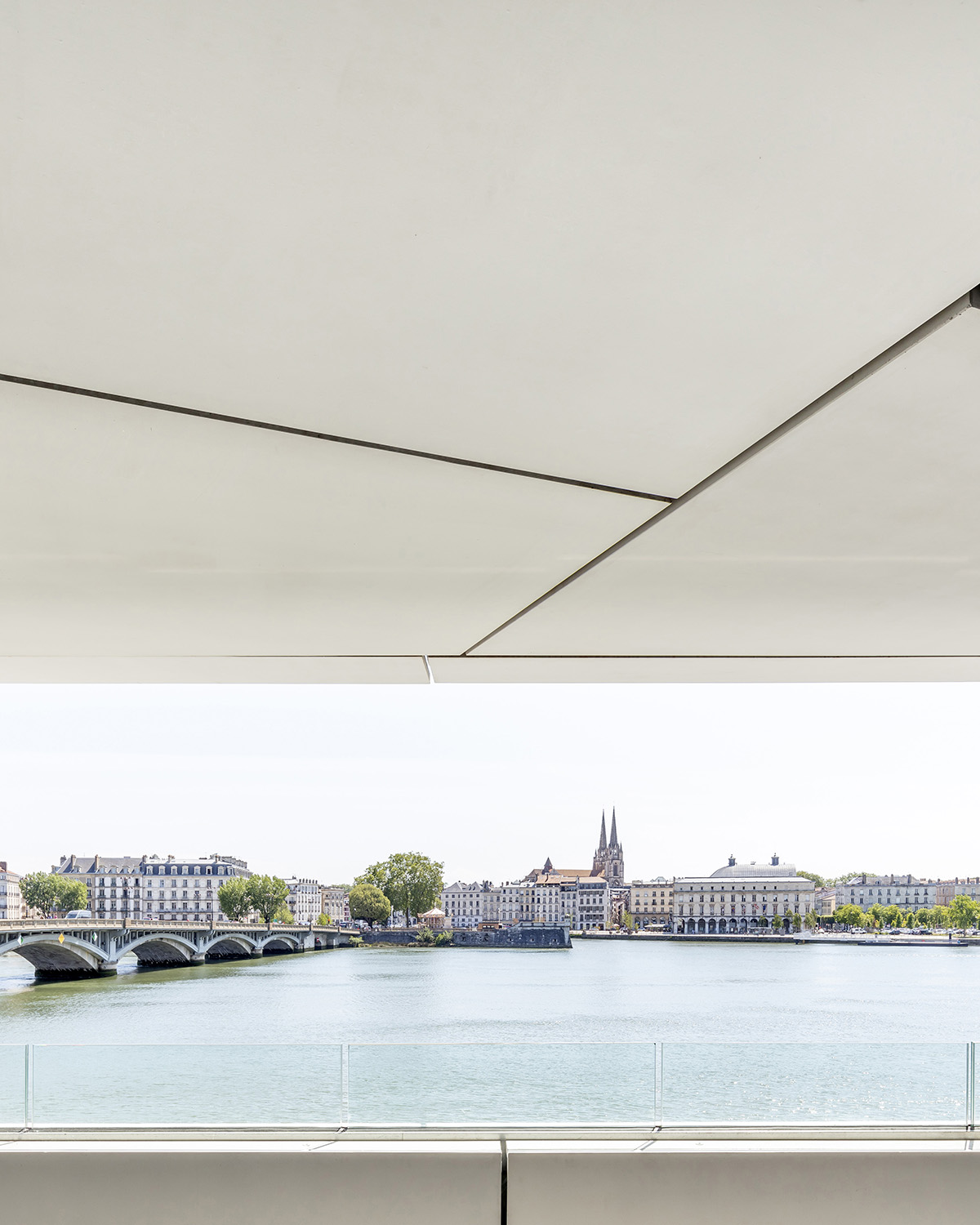
The new movie theatre, accessible at ground level, offers 207 seats and six for disabled people. In order to preserve the comfort of art-house cinemas compared to more block- buster-oriented ones, I have provided generous screen sizes, comfortable seat pitch and good headroom. The two administrative offices are directly linked to the projec- tion booths. The projectionist can move from one to the other in a minimum of time. The two dwellings, delivered raw, are superimposed on two levels. They are open to the city and the banks of the Adour through wide framing and their loggias, as well as to the internal space embel- lished with large terraces. At the rear, one accesses via a dedicated stairwell and lift.
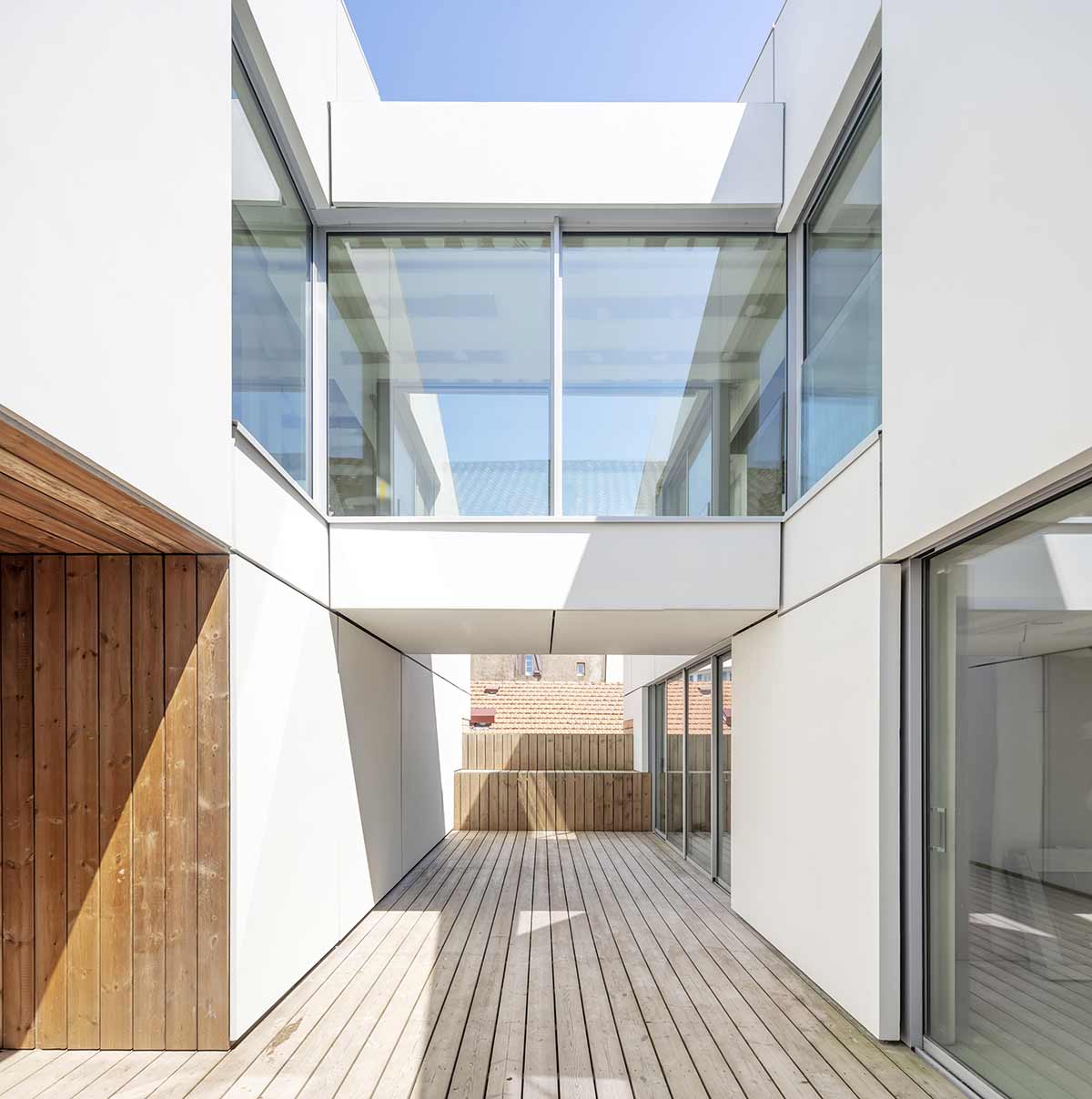
Location
Bayonne (64)
Client
Ville de Bayonne
Financing
Bayonne city, Pyrénnéés Occidentales département, Grande Aquitaine region, French state, EC and the Centre National du Cinéma
Operator
Cinéma l’Atalante
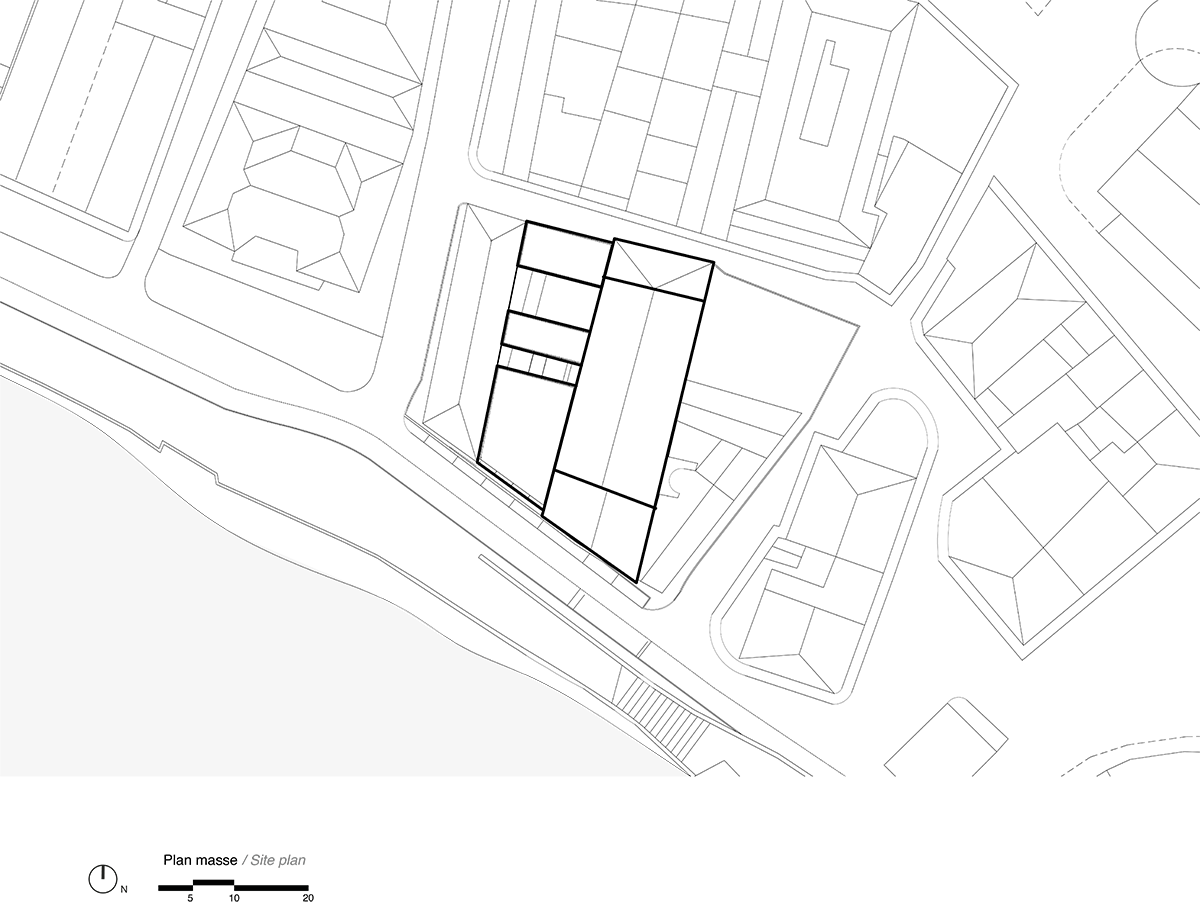
Architect
FARIDAZIB
Project Manager
Mélanie Surjon
Assistant Project Managers
Léa Billot, Dhouha Hamdi
Acoustics/Scenography
Impédance
Economics
Cap Ingéléc
Structural INGINEERING
Adour études, ECTA
FACADE ENGINEERING
LRing
Architectural fluidity Fire Prevention Systems
Cap Ingéléc
Technical control
Veritas
Construction Site Coordinator
Anco Atlantique
Scheduling Management & coordination
SCP Piquet-Grossin
Photographer
Luc Boegly
Surface
1 930 sqm
Cost
3.75 M€
Competition
2013 Winner
Delivery Date
May 2021
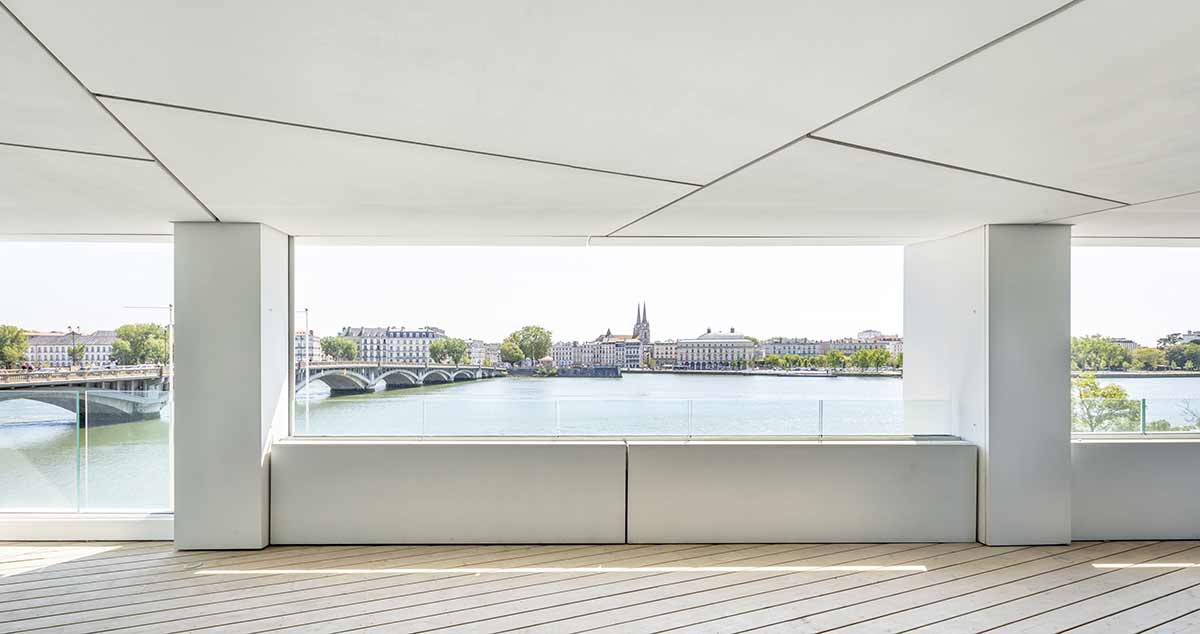
CONSTRUCTION COMPANIES
STRUCTURAL WORK, CONCRETE FACADE, SCREEDS
Oyhamburu
SPECIAL FOUNDATIONS
Dacquin
ROOFING, WATERPROOFING
Disfeb
UHPC FACADES & EXTERNAL JOINERY, OCCULTATION
Eiffage
STEEL FRAME, METAL WORK, LOCKSMITHING
DL Pyrénées
PARTITIONS, FALSE CEILINGS
Goyty Jean
INTERIOR JOINERY
Etchenausia
TILING, EARTHENWARE
Oyhunburu
PAINTINGS, CARPETS, FABRICS
Atlantic revêtements
ELECTRICITY (HEAVY & LIGHT CURRENT)
Ineo
HEATING, VENTILATION, PLUMBING
Spie
LIFTS
APAA
VRD
Oyhunburu
AUDIOVISUAL EQUIPMENT
Auvisys
CINEMA HOUSE FURNITURE
Klesco
LAYOUT
Etchenausia

